Dream Park RPG by Maxwell Lord
Introduction
Original SA post Larping for Fame and Fortune: Dream Park, The Roleplaying Game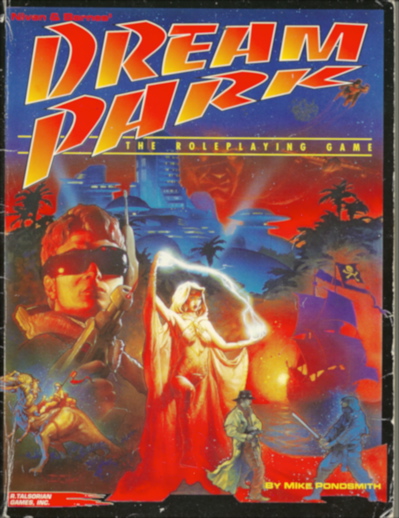
Dream Park , by Mike Pondsmith, is based on a trilogy of novels by Larry Niven and Steve Barnes- Dream Park , The Barsoom Project , and The California Voodoo Game . The books all take place in a futuristic amusement park populated with interactive robots, holograms, and virtual reality attractions- it's like Westworld, but the robots don't go berserk and kill everyone. (I know, you're disappointed.) Instead, each book focuses on a mystery or bit of espionage relating to one of the Park's big Games- multimillion dollar live roleplaying events where patrons try to defeat a scenario controlled by a Gamemaster who is out to kill as many of their PCs as possible. They're all pretty good books- if you can get past the premise that LARPing will be a mainstream sport in the future, they've got great characters and sharp writing and manage to make the games suspenseful. Hunt 'em down.
So, in the RPG, the players are Park patrons who are playing PCs in the Games- you can be wizards or crimefighters or cyberpunk engineers, but you have to watch out for what powers and abilities the Game will allow. I loved this game when it first came out (1992), and while in retrospect it has a lot of rules problems (*cough* superpowers *cough*), it also has a lot of neat ideas.
The Introduction
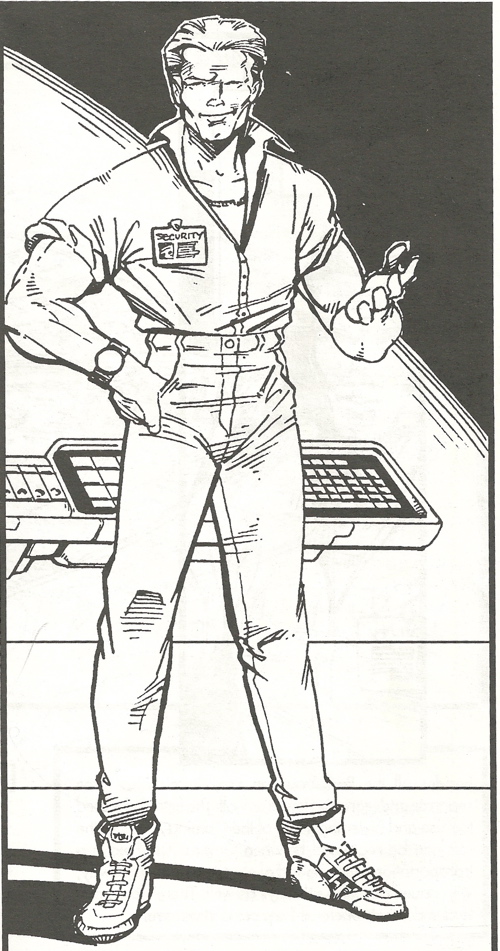
Hmm... Hi there. My name is Alex Griffin.
Alex is the chief of Dream Park security, and the protagonist of the books. The Park Director stuck him with the assignment of giving us a tour of the place and explaining how it works, because he played undercover in a couple of Games in order to track down killers and saboteurs. So he's going to show us the Park.
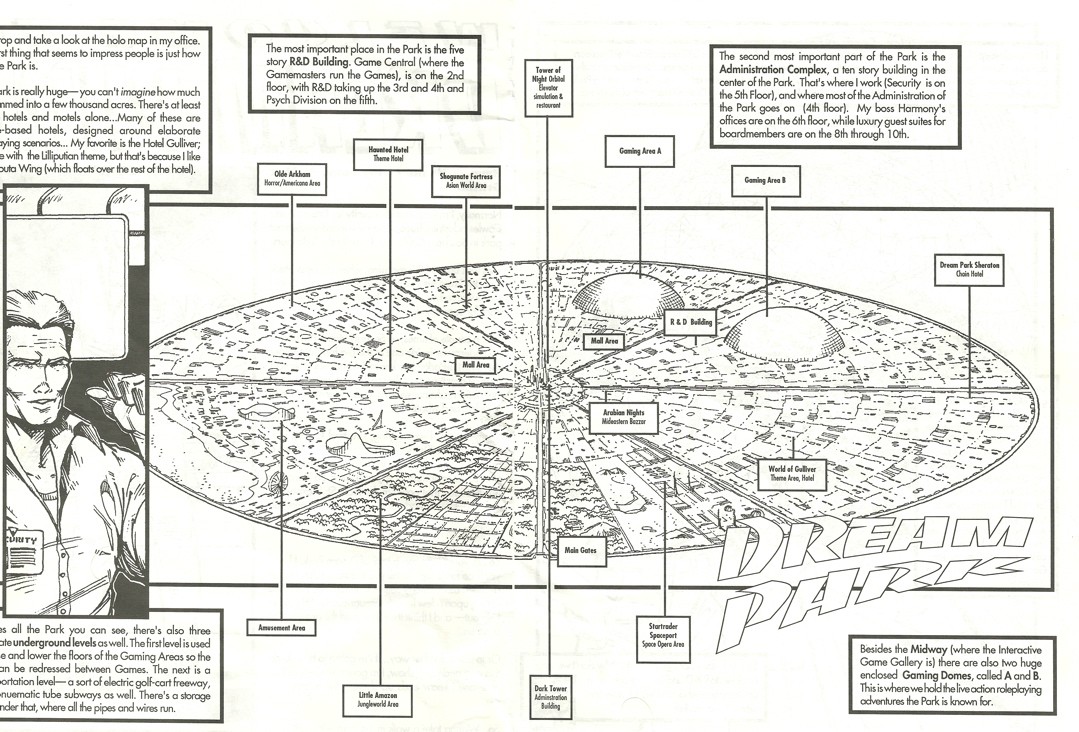
Most of the place is divided into separate "worlds" for the patrons to hang out in- there's a sci-fi area, a fantasy area, a horror world, etc., complete with theme hotels. The Dark Tower in the center is where the administration is, but the important part to us is the two big domes. These are Gaming Areas A and B, where the big Games are held (most of the time- the California Voodoo Game was in an abandoned condo complex ruined by the Great California Quake of 1995. Remember that?) Gaming A is 740 acres, B is half as big, and they're laced with sensors so the Park's scanning technology can record everything that goes on and relay that info in real-time to their computers, as well as provide material for secondary sales, TV coverage, etc. There are book versions of each game and movie versions and home versions for DreamTime VR sets, etc.
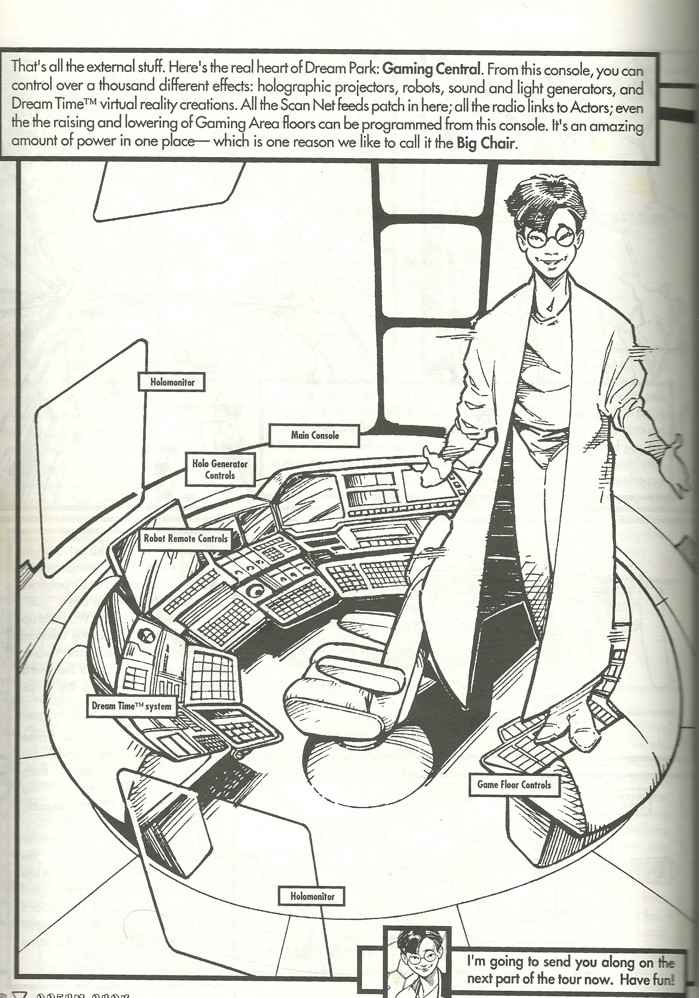
Tom Izumi (Dr. Tomisuburo Izumi) is the head of R&D, and he explains all the effects stuff. He's floating over the Big Chair, where the Gamemaster sits and directs the action.
Dream Park tech is a mishmash of things. Most parts are played by human actors, in costumes or enhanced by virtual reality illusions. (Robots are also used for monsters and such.) All players in the game wear slim VR headsets (which can be disguised as visors, headdresses, etc.) allowing them to see anything that isn't really there. The Park's ScanNet ™ technology has an AI that filters out the junk scan data so they can focus on important movements and actions, like whether a character's fake sword connects or his prop gun is lined up with the target when he pulls the trigger and whether that means a hit. There are holographic illusions too, mainly because the first book was written in the mid Eighties and holograms were a big thing and we thought they could do anything. Finally, the Park technicians can create all sorts of illusions by raising and lowering sections of the floor (you could climb a mountain and not actually go very far horizontally or vertically), using fake snow that incorporates actual ice, etc.
Basically the Park can do anything. The Park is supreme. All Hail The Park.
(And the robots, again, DO NOT go berserk and kill everyone. At least so far.)
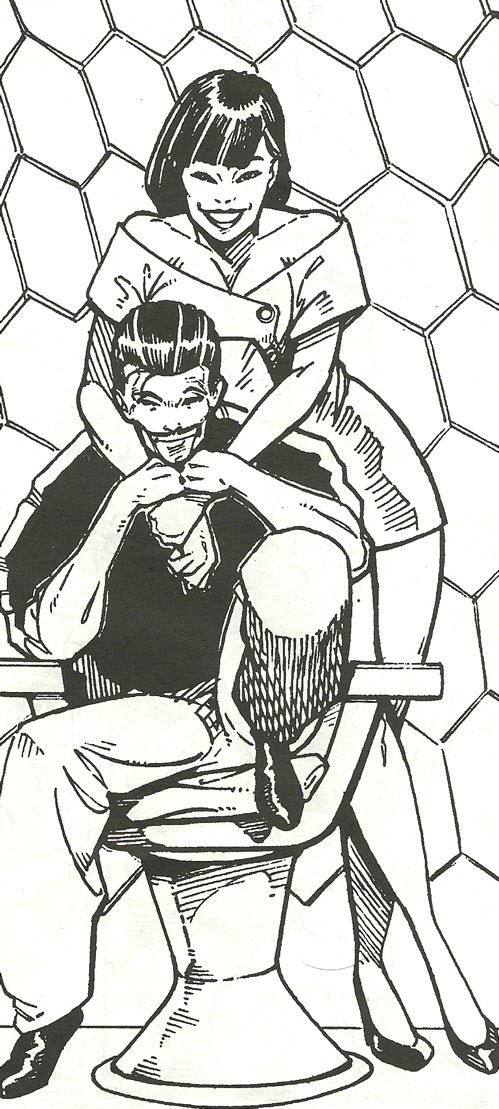
Players, know thy enemy. Richard Lopez and his wife Mitsuko are Gamemasters, and they explain the whole "What is Roleplaying" bit. Which we already know. But they also explain how they can drop the players into entirely new situations each game, in settings which are a mishmash of genres and conventions, and they have to figure out the rules each time. ( Book spoilers: This is apparently set after The California Voodoo Game, except Richard was dying of cancer at the end of that and he's looking okay now. )
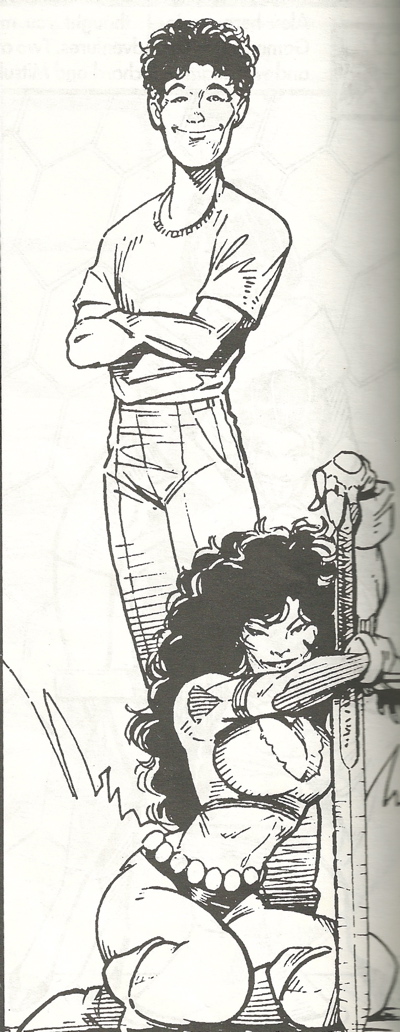
This guy. This guy right here. Smug and punchable though he looks, like the ultimate nerd fantasy complete with hot warrior babe at your feet, Tony McWhirter is my favorite character in the books. He's a Gamemaster too, and his girlfriend Acacia Garcia is a player, going by Panthesilea in game. ( Well, until the last book where her character is permanently "killed out", but apparently she's got a new one. ) Tony rambles a bit about how you have to work out the mythology and "rules" for each new game you create, and talks about the International Fantasy Gaming Society and how it's basically the governing body for the games, offering support for GMs and helping players get exposure if they kick enough ass.
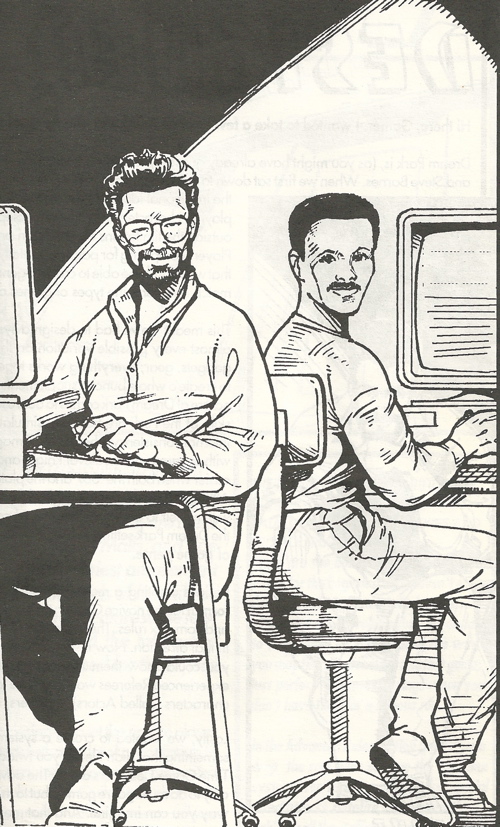
And now Larry Niven and Steve Barnes themselves show up, introducing themselves as "True Crime" writers who get to publish the real-life intrigues of the Park, so long as they change a few names. This contributes nothing but it's cute and adds to the meta-ness.
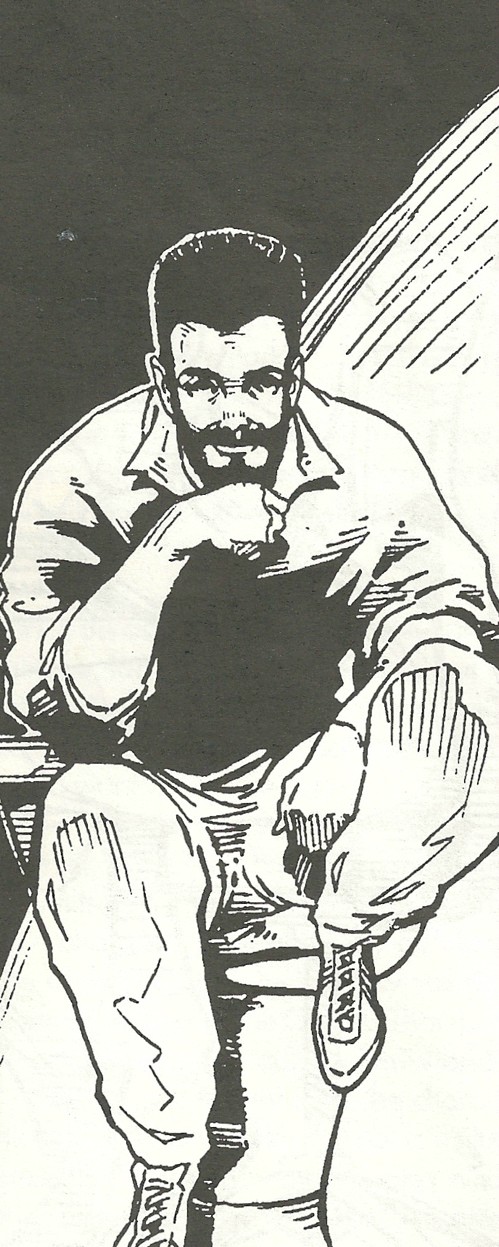
Finally, the actual game designer Mike Pondsmith shows up to explain the concept of the design. Since you can play anything in Dream Park and be in any situation, he tried to come up with a simple rules set that puts mostly everything at the same power level- that is, a Jedi and a samurai could have a duel and the lightsaber won't just chop the sword in half, a super ray gun is no more powerful than a Magnum, etc.
At this he... well, it's a design that could have done with a revision or two, but it IS a fairly simple system and easy to monkey with. For the time it was practically cutting edge.
I'll be off various places for the next week and a half, but when I get back we'll delve into... The Quik Start ! And yes, that's how they spell it.
Chapter 2: The Quik Start or What is this, a miniatures wargame?!
Original SA post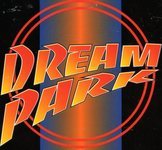
Dream Park: The Roleplaying Game
Chapter 2: The Quik Start or What is this, a miniatures wargame?!
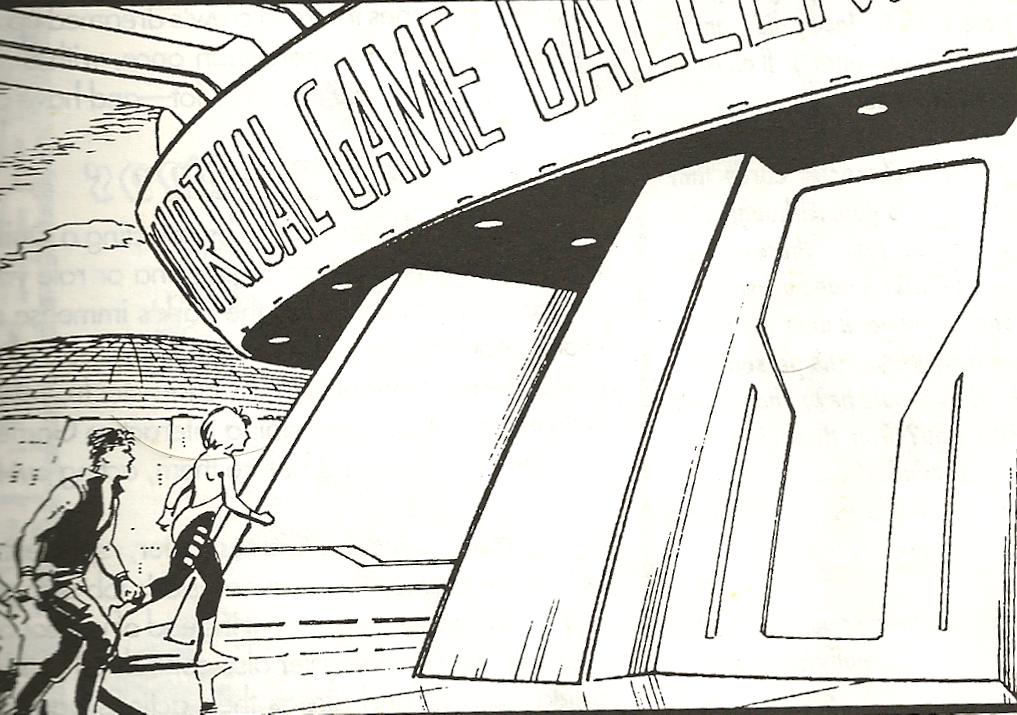
Most people who come to the Park don't come for the Games- those are expensive and demanding marathons that take place over days. Most people come just to gawk at the holographic entertainment and ride the Gravity Whip (a guaranteed 30 seconds of freefall!) and shop. But if you wanna get your feet wet, you go to the Interactive Gallery (or Virtual Game Gallery, depending on whether you believe the text or the art). Here you can participate in a short afternoon's adventure with a pregenerated Quik Start character.
In game terms, these are basically three very short little scenarios, almost all combat, that get you used to the rules. (This is a canny use of the books as source material- the gallery is referenced in both The Barsoom Project and California Voodoo Game, and two of the three scenarios are from those books.)
The book comes with a bunch of small character cards, and I have lost almost all of them. Thankfully, someone at RPG Geek managed to scan a few, so here are some samples.
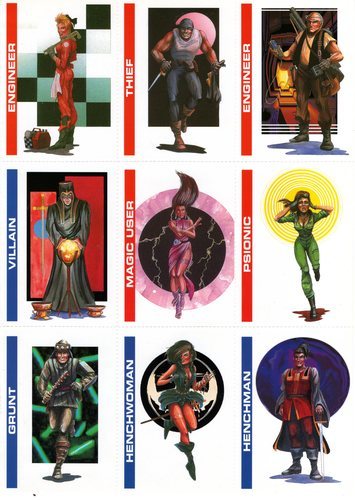
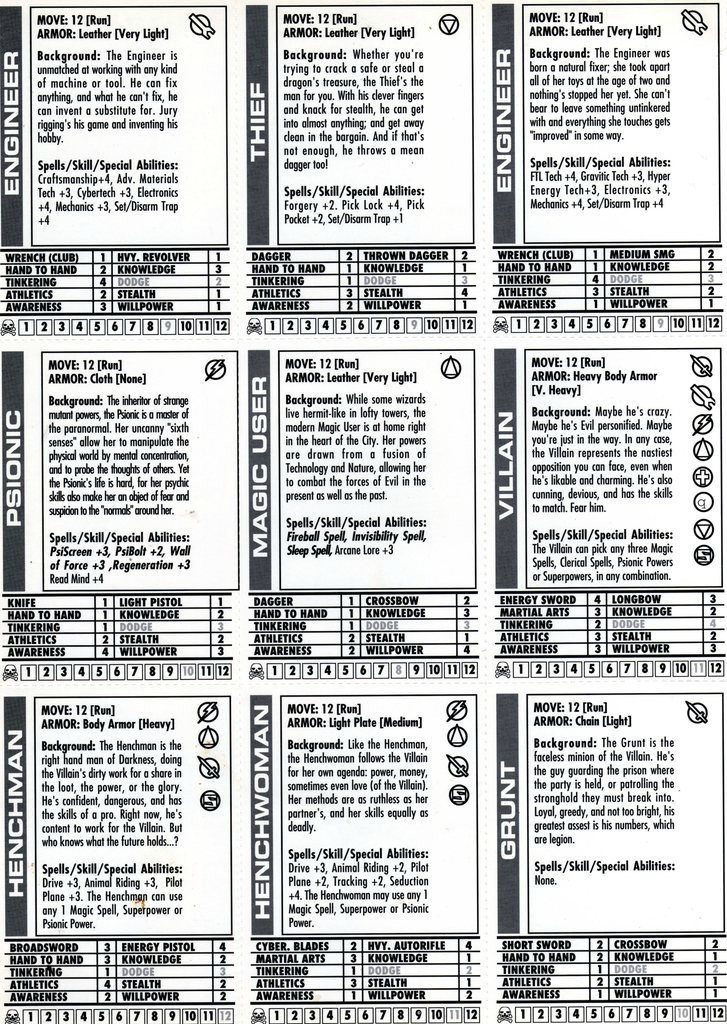
The red cards are PCs, the blue cards are used for the NPCs. On the back, on the bottom you have how many hit points each dude has. Above those are their basic skills (which in the Quik Start also show what weapons they use), and then a description of their special abilities. Note the little icons in the corner- those denote their classes and the kinds of powers they can use. Spells and superpowers have their own cards describing their effects- to use them you just play 'em. (The Psion's bonuses seem to be an error- you do make an attack roll for one, but the others aren't necessary.)
So you select characters (some of the ones not shown include the Superhero and the Starknight, who has his own power armor) and one of the three scenarios. Each scenario comes with its own little 9 x 12 map which you can photocopy- here's the one for The Crystal Maze:
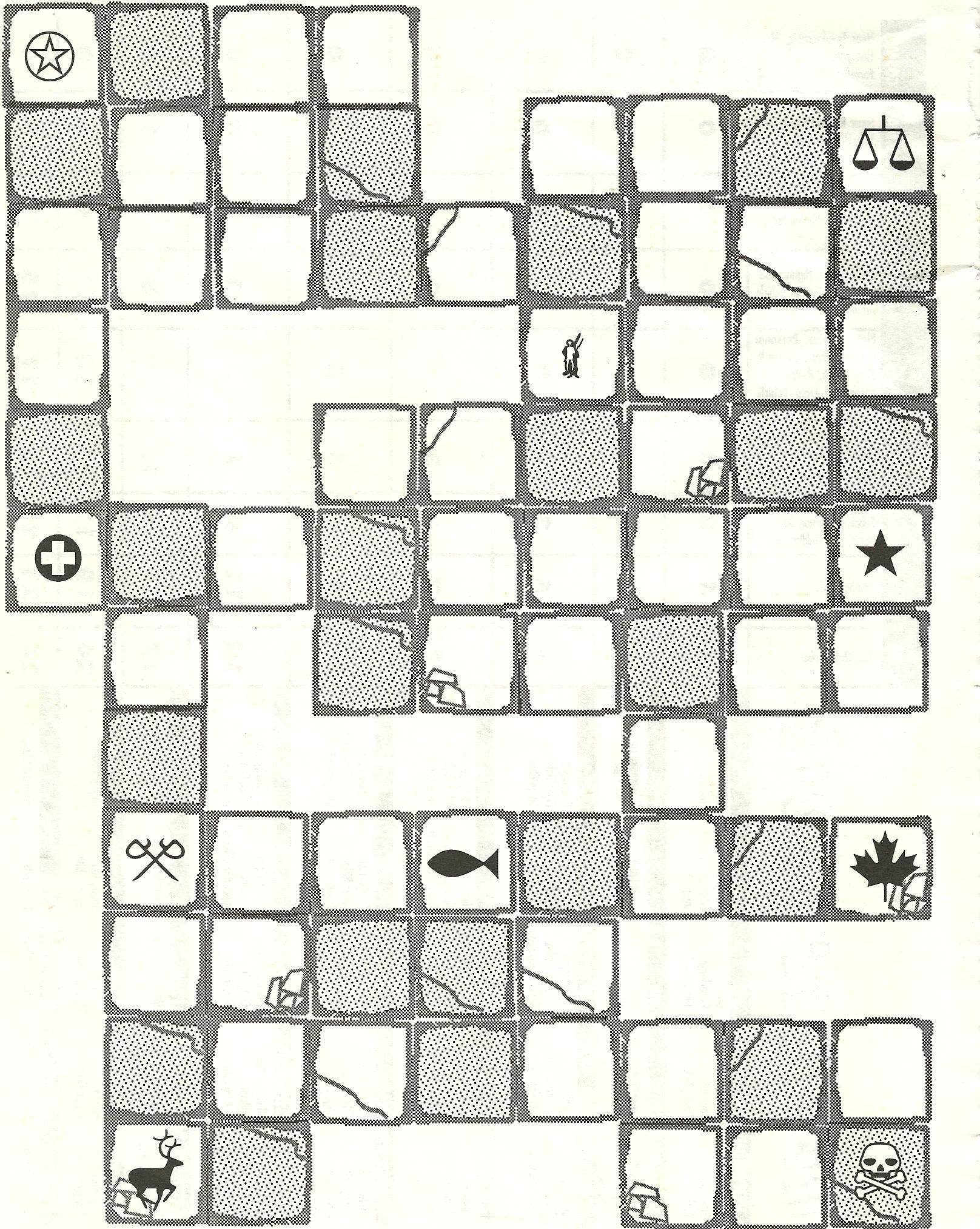
Players always start on the circled star, NPCs set up near the skull & crossbones. Neat.
The rules depend on tactical distance, hence the maps. Each turn you can move four squares/inches, and do something else- either attack or use a spell/skill. All missile weapons have a range of 8 inches/spaces, you use the right Basic Skill and roll a d6- the target rolls a d6 and adds their Dodge. If you hit, you do damage based on a table where you cross-reference the weapon you used (they all fall into damage categories from Very Light to Cosmic) with the opponent's armor. People take turns starting on the Gamemaster's left and going clockwise around the table, and so on until the game is done. Easy enough.
(This game is why I got really confused around the time of D&D 3e and later 4e when everyone claimed the tactical movement stuff took away from the roleplaying, like this was some new and terrifying imposition. Though I was annoyed at having to find my own counters and such.)
Scenarios!
The Crystal Maze
No, not that Crystal Maze ! You can actually win this one. On the map above, all those little icons are the Holy Relics of Saint Shannadan, stolen from Castle Arragon by the evil Dragon Lord and now lying in the Crystal Maze. The Dragon is dead, but the Evil Mage Morrolin (the Villain card) and his henchmen (the Henchman and Henchwoman cards and as many Grunts are you need to match the number of players) are after the Relics. You start on your space, they start on theirs, and each side tries to collect all of the items and return them to their starting space. Each relic has a power- the cross is a healing amulet which gives wounds back, the fish grants dodge bonuses, the leaf produces a scent which makes opposing players stop for a turn and I guess makes them wonder how big the universe is. (I only just now got that it's a pot joke.) Each party can use any item's power once- if the other side retrieves it they can use it too.
(Something like this was in The California Voodoo Game, only instead of an evil party there were two teams of PCs pitted against each other, in preparation for the titular tourney game.)
The Keys of Time
The characters have been travelling in Professor Thrintwhistle's time machine, and are taking a break in the Cretaceous Period. But the idiot dropped the keys to the time machine near a cave of Deinonychus (which are like velociraptors with worse agents), and as the day warms up, the dinos are starting to stir. There are three more of these guys (represented by the Monster card) than there are players in the party, and they appear three at a time. You have to get the keys and get back to the start- the dinos have to eat at least half the Party before that happens.
(Again, something like this was in The Barsoom Project- it was a more involved story with anachronistic cave people and such which we only saw the last part of.)
20,000 Leagues Under the Microscope
With the players' offscreen help, Captain Nemo and Sherlock Holmes have tracked down the evil Professor Moriarty and the World Crime League to their underwater volcano lair. As the submarine surfaces inside a volcanic lake, though, Moriarty zaps it with a shrinking ray, reducing it to microbe size and turning the lake into a bunch of droplets. However, now a bunch of amoebas, now the size of a streetcar from your perspective, are closing in hungrily on you.
After all this setup it's a bit disappointing that this is just basically keeping the four amoebas (which use the Terror card, representing really big and unpleasant monsters) from destroying the sub for ten turns. I kinda want to expand on this premise.
So you can see all the scenarios are pretty rudimentary- there isn't even room to use the noncombat abilities of the Quik Start characters. Some of the Quik Start rules are a little unclear too (like the Psionic thing). It's a good way to get used to the rules of the system and get comfortable using it, but I can't imagine going back to it once you've gone on to the full game.
Also, you'll notice that the Gamemaster can "win" each scenario by defeating the players. The game isn't quite as adversarial in the full version, but it does encourage the GM to go for the throat- the Games in the books have plenty of PC deaths, and since the PCs can just pop back up in the next Game it's not a huge deal. Combat as Sport? You're soaking in it.
Next Up: Advanced Characters!
Chapter 3: Advanced Characters Part 1 or Have You Ever Been Meta
Original SA post
Dream Park: The Roleplaying Game
Chapter 3- Advanced Characters Part 1 or Have You Ever Been Meta
Be forewarned, this write-up got long so I decided to split it in two.
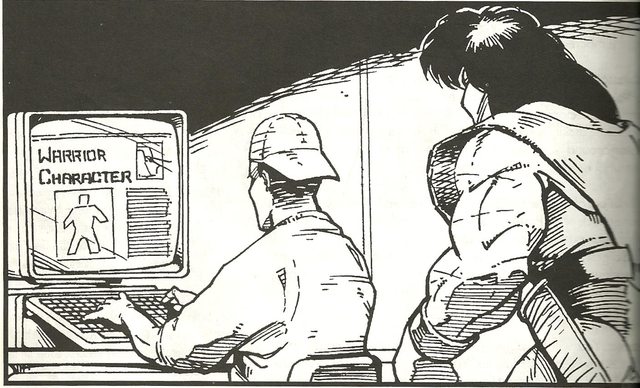
So it's time for us to actually make a character. Well, first we have to make a player, that is, a guest at Dream Park who's going to start playing in the games. The game splits this up into "visitor" and "role", the latter being the persona they take on.
(In the books this is sometimes a big split, sometimes not so much. Acacia Garcia identifies strongly with the character of Panthisilea, but other players usually play thin variants on themselves- Oliver Norliss calls himself Ollie the Frank, Mary Martha Corbett becomes Mary-Em, and Chester Henderson is just Chester Henderson because that's how he rolls.)
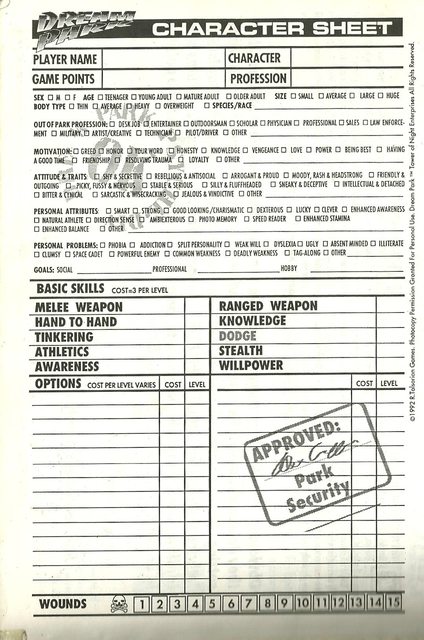
First things first, I really like the character sheet. They're actually printed two on one page, so you end up with a small, compact thing, and the Security stamp by Alex Griffin is a nice touch. In general the game's graphic design is one of its strengths. (I also love the logo. You can just imagine it slapped on T-shirts and drink cups at one of a hundred gift kiosks.)
So before we get into game stats we're asked to work on the background. Which means I should think of someone to take through this. Follow along on the character sheet- the little check-boxes start near the top.
Okay, I can do this. A woman, maybe? Call her Jen. We start with the basic physical description stuff- sex, age, size, body type. Let's say Young Adult (20 to 29), average height and build. The game doesn't expect you to be too specific, which is fine by me. Race/Species comes up later- basically you can have your visitor's role be a different species, though it's basically cosmetic and doesn't convey any game advantage. You just get makeup and/or holographic/virtual enhancements.
Out of Park Profession. Okay, this is where it gets interesting. Theoretically it's something that pays decently (because getting into the Games can be expensive) and gives you a good amount of vacation time. The boxes give us some broad suggestions. You know what? Artist/Creative is neat. Jen Meyerson is a studio musician. Plays keyboard. Not famous, but she gets enough work that she can head to the Park at least once a year.
(A sidebar also suggests that you could have an "in-park" job, like a technician, ride operator, prop shop, bartender, etc.)
Motivation? I'd assume most guests are here to Have a Good Time, but some of these are not so obvious. This is for the visitor and not the role, though I'm not sure how, say, "Honesty" would apply. So let's choose that one! She's just an honest person and gaming helps her be in touch with who she really is. For Attitude and Traits, Friendly and Outgoing. She's comfortable in-game.
Personal Attributes and Problems are an optional advantage/disadvantage system. Most of the Attribtues are bonuses to various skills- for example, Smart gives you a bonus to Knowledge or Lore skills, Natural Actor enhances Acting or Persuasion skills, etc. They all have a base bonus of +1, and to raise it higher you multiply the base cost by the bonus you want. To take an Attribute or Attributes, you have to offset their point value with Personal Problems. Some of them are skill penalties, others are psychological problems like Addiction or Split Personality. There are even a few ones that clearly apply to the role only- Deadly Weakness gives your character some kind of Kryptonite, Powerful Enemy and Tag-A-Long impact what happens to you in-game, etc. It's a bit confusing at first.
I won't go crazy with this. But I'll say Jen is Ambidexterous, which obviously means she uses both hands equally well, and gives her a +1 bonus to two-handed attacks. That costs 1 point. I'll also give her Photographic Memory, which gives her a bonus to Programming, Deduction or Language Skills. That's another 1. So for a disadvantage… Dyslexia. I've known music people with it, so it's not a big stretch. This is a 2 point Problem, and it means any reading-related roll is made at half skill. Don't give her the scrolls.
Before we even get to the mechanics, we'll need three Goals- a Social, Professional, and Hobby goal. All of these are out-of-Game, and mostly work if the GM is planning to run this like the books and have intrigue and subplots outside the Games themselves. So
Social- Jen wants to make more friends! In her game group, outside her game group- she works a lot and doesn't get to meet many people away from work, so she'll want everyone to Friend her on Facebook 5.0 and make sure they all do something after the Game or something.
Professional- Jen wants to do her own stuff. She's been working on some songs and is pretty good- sort of a Laurie Anderson type- but is looking for a big break. So far the executives aren't that interested.
Hobby- Jen is interested in sound design and engineering and would kinda like to know how the Park does it so well. She could be tempted into learning more than she should about the Park's secrets.
I'm gonna split the review here, and the next installment will be the rest of this chapter plus the skills and powers chapter. Who does Jen want to be in the Park? Well, I've got an idea...
Next Time: Advanced Characters- Professions, and Options!
Chapters 3 & 4: Advanced Characters Pt. 2 and Options or Showtime, Synergy!
Original SA post
Dream Park: The Roleplaying Game
Chapters 3 & 4: Advanced Characters Pt. 2 and Options or Showtime, Synergy!
After much soul searching, Jennifer Myerson has decided what she wants to be- a hip futuristic illusionist from a cyberpunk future. She can use the cyber-gear to cover up her virtual visor and gauntlet, and she's already got the costume planned out based on one she wore in Keys to Time. Now to translate that into stats!
If you remember the character cards from earlier, all Dream Park characters have 10 Basic Skills- Melee Weapons , Ranged Weapons , Hand to Hand , Knowledge , Tinkering , Dodge , Athletics , Stealth , Awareness , and Willpower . Most of these basically explain themselves, with Athletics being the main "strength" score for the game. (Which means you can be a great fighter and not be very strong.) Awareness is perception, Willpower is your mental fortitude, etc.
There are ten Professions, each of which gives you starting values for the Basic Skills and a Base Wound level. Generally each Profession as one 4 point skill, two 3 point skills, three 2 point skills and four 1 point skills. You'll get to tweak those a little.
-
Fighters
have their 4 in Melee Weapon, with a 3 in the other two "weapon" skills. Their base wounds are 6 + 1d6.
-
Magic Users
have their highest skill in Knowledge, and get to cast spells. Base wounds are 4 + 1d6.
-
Thieves
have their highest skill in Dodge, with Ranged Weapon and Stealth backing them up. They also get 4 + 1d6 wounds.
-
Engineers
have a 4 in Tinkering, and actually a 3 in Melee Weapon so they can use giant wrenches for self defense if necessary. Good kind of utility support class, with 5 + 1d6 wounds.
-
Clerics
are your healbots, and their highest scores are Willpower (4), Awareness and Melee Weapon. Again, support staff. Base wounds are 5 +1d6.
-
Loremasters
just know a lot. Their highest skill is actually Awareness, not Knowledge, and since they don't get spells they seem a little weak at first. Their skills can be important, though, depending on how much the Gamemaster remembers to make puzzles and riddles and so on an important part in their Games like they were in the books. Base wounds are 4 + 1d6. (In the books a party HAD to have a Loremaster, and they were also always team leader. The game doesn't push this quite as hard.)
-
Psionics
have crazy mental abilities, aren't much for combat, but have great Awareness (4 again) and Willpower and a good Dodge so they can at least get out of the way easily. Base wounds are 4 + 1d6.
-
Superheroes
are… well, this gets weird later. Their highest skill is Hand to Hand, which isn't that useful at first since unarmed strikes don't do much damage, BUT they get access to Superpowers. But Superpowers are very weird. Wounds are 6 + 1d6.
-
Multiclass
is generally not a good option. It's in the books, but basically, this class counts as a hybrid of two for purposes of skills and options (see below.) To compensate they get shitty stats, with three skills at two and ALL THE REST at one. Base wounds are 4 + 1d6. Ignore them.
The game talks a bit about "Subprofessions", but those are just alternate ways of describing certain classes- i.e., a Thief could also be a Ninja or a Spy, a Loremaster could be a Detective or Scientist, a Cleric could be a Medic, etc. They're ways of dressing up. (For some reason Fighters can also be called Bards and Rockerboys.)
Jen decides that Psionics are the way to go. Magic's cool and all, but she wants to think people to death. The game gives you 3 additional points to add to your Basic Skills. There's no starting maximum, but the text warns you against maxing out- you don't know what will be useful in a given Game. Jen might find that her Psionics don't work in a given setting, so she bolsters up her weapons skills, favoring Ranged Weapon so she can attack from a distance. Her stats end up looking like this:
Melee Weapon 2
Ranged Weapon 3
Hand to Hand 2
Knowledge 2
Tinkering 1
Dodge 3
Athletics 2
Stealth 1
Awareness 4
Willpower 3
Jen rolls a 5 to add to her Base Wounds, so she can take 9 points of damage. Good show.
Now, if Jen wanted to get really creative, you can create a new profession. You and the GM decide what Options you favor, and set up Basic Skills as described above (one at 4, two at 3, etc.) Finally, the Gamemaster determines your Base Wounds, which sounds really handwavey, but since the range is 4-6, it's not a huge deal. (Basically, the more fighty professions get 6, support guys get 5, wizards and sages and such get 4.)
You'll be able to increase your Basic Skills as play goes on, but I'll put that off until we get to Game Points.
Options
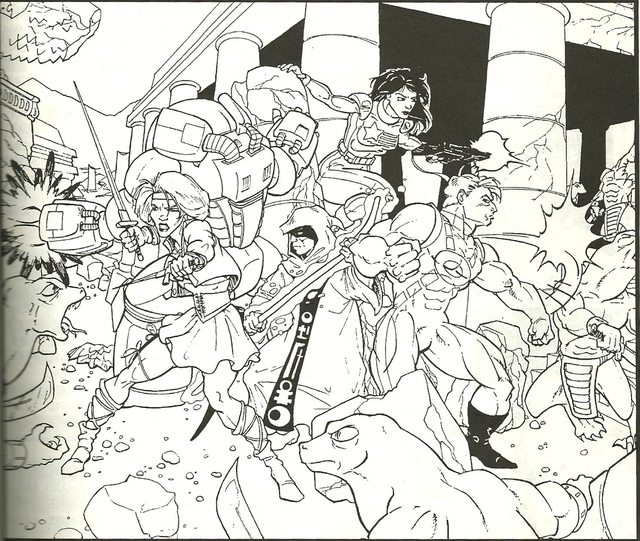
This is where you have to make the tricky choices. You get 20 points to buy your additional skills, powers, and gear- and that's not a lot of points as we'll see. The good news is that any points you spend on Options, now and after Games, can be switched around between Games. You can cash in skills, weapons, equipment, etc. in preparation for the next Game depending on what will be allowed, so you don't get stuck with a non-functioning ray gun in The Shogun Showdown Game.
First there are Optional Skills. These are all ranked by how easy they are to learn- you can buy points in an Easy skill on a one for one basis, a Simple one takes two for every one, Hard takes three for one, Very Hard takes four for one, and finally the Extremely Hard Skills cost five points per rank. Also, if a skill or power is associated with a class that isn't yours, the cost is double. Multiclass characters get to pick two skill groups, but I'm still not convinced that's worth the trade-off in horrible stats.

If you remember the symbols from the back of the character cards, those come up again as a way of easily indicating what skills are associated with what Professions. (If any- there are quite a few generalist skills.)
Fighters, for example, get a lot of skills for weapons that are trickier than the norm. Archery lets you use bows, Fencing lets you use rapiers, sabers, and katana (all of which do more damage than regular swords), Martial Arts are deadlier than normal HTH attacks (though still relatively weak), etc. Loremasters get skills like Identify Magic Object, Understand Tech, Arcane Lore, etc. The skill list is pretty dang long, but again, considering you can swap these out between Games, the decision paralysis isn't too bad.
Now, a lot of skills also have Limits, which are defined by time periods- Ancient (Middle Ages or below), Historical (Renaissance to 1900), Modern (well, -ish given this game takes place in the near future) and Future (full on sci-fi stuff). For example, Electronics will only work in Modern and Future settings (though for Ash wanna-bes, Chemistry works in all eras.) This same classification scheme applies to Gear.
Magic spells, Cleric spells, and Psi powers all use the same basic system, but different lists. You buy them like skills, and to use them you have to roll 1d6 + your skill level and get a 6 or better. However, each time you use a spell or power, your skill level for the next use is reduced by one, and once it's at zero, you can't cast it anymore for the duration of the entire Game. I guess that's one way to take care of the 15 minute adventuring day.
The Clerical Spell list is short- there's Healing, obviously, Cure Disease, Turn Undead, Banish various nasty things, walking on water, etc. Nothing too remarkable there. The Magic User list is fucking huge, an entire page just for the list, and it's got all your easily broken D&D favorites- Slow Time, Teleport, Touch of Death, etc. Psionic Powers are mostly what you would expect your typical scanner or Jean Grey wannabe to be capable of, though there are specific forms like Cryokinetics and Hydrokinesis.
(The only problem I have with some of these is honestly the in-setting trickery involved. I'm not sure how the Park technicians can simulate teleporting to any location anywhere, or make people fly. But hey, anything can happen.)
On the one hand, the sheer expense of these things may prevent too much of a Caster Supremacy situation- the majority of spells are Hard or above to learn, and you have to pay for each one, so it's not a LFQW thing. (And technically anyone can learn them- just at double the cost if you're not in the Profession.)
Let's get back to Jen, because she's marking down some decisions. Mental Illusion is the Psi Power she most wants, and she figures she'll need some offense and possibly a defensive power as well.
And now, Superpowers. Superpowers work very differently, to an extent that, well, you gotta watch for 'em. The thing is, Superpowers Always Work. There are no ranks- you buy the entire thing, and it always goes off and never runs out. If it's a ranged attack it hits anything in its range. You wanna fly, you fly. If you have Super Strength, that means you do way more damage with your punches and kicks, and can lift cars and so on.
The one balance for this is that they cost a LOT. You're almost certainly only going to be able to afford one at character creation (the only ones that cost less than 10 points are "Tough", which gives you light armor, and Telekinesis, which you buy in 5 point increments.) Some are completely out of the reach of starting characters.
Well, okay, there's another balance- as with any other kind of power they may not work in a given Game, and "No Superpowers" is pretty much the most common rule for Games. The book advises the Gamemaster to think a lot about if they even want to allow Superpowers. And of course without them, Superheroes are just folks who punch with more accuracy.
So a big problem here is that there's just so much. I'm gonna go and say they should have had all "supernatural" powers work on the same effect-based system, and you can skin them to be magic spells, psionics, superpowers, etc. It's how a real Dream Park would probably handle it anyway.
We finish up with Weapons, Armor, and Gear, all of which are bought with Option Points. As mentioned before, the rules are balanced so that the tech level of a given weapon doesn't matter- a Longbow and a laser pistol both do the same damage, so theoretically they're all equal, and costs are roughly similar with a few weird exceptions. (Of course, this does give an advantage to Ancient weapons since they're almost never going to be disallowed, whereas Future tech is less likely to see use. But if you know you're going to play The Star Knights Game, why NOT have an Energy Sword?)
There are also vehicles which cost a whole lot of money- a party that's been through a lot of successful games might be able to pool points to buy themselves a Space Cruiser or Man of War. You can even buy fighting Animal Companions, and at least a few of them are within the range of starting characters. And finally there's a bunch of miscellaneous gear.
After a lot of indecision, Jen makes her choices. She'll take Mental Illusion at 2. Her illusions are based on proximity to the target (Small Area range, so she has to be within 2 spaces/inches on the map), but that's the case with most Psi powers. Forgoing the more expensive offensive powers, she gives herself Emotion Attack, which basically makes a single target overcome with a single emotion (fear, love, hate) for 4 turns, enough to give the team an advantage. That'll cost her 6 for 3 ranks. She needs something for when those burn out, so she buys a Light Autopistol at 6, which has a range of 24" and does Serious damage. Two points left, so she buys herself two ranks of Streetwise.
Oh, and a name. Well, something punky, not too far from her own, but distinctive. She puts down "Jenny Outrageous" with a note that she reserves the right to change it to something better.
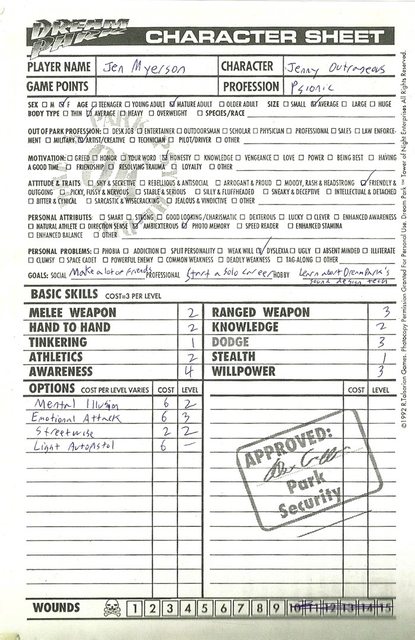
So, a nifty starting character- not yet truly outrageous, but any decent Loremaster would be glad to have her on board. In retrospect chargen is a bit more complex than it needs to be simply because there's so much to look at, but you can pull some good tricks with it.
Next Time: Advanced Rules! We finally get to see what the Hell these numbers mean!
Advanced Rules or Of Course There Are Diagrams
Original SA post
Dream Park: The Roleplaying Game
Chapter 5: Advanced Rules or Of Course There Are Diagrams
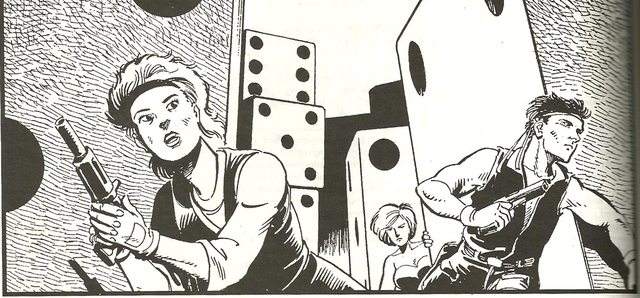
So we finally get to find out the rules. I've been slacking on this chapter because it's dense and full of stuff, even though the designers note it's mostly designed to stay in the background. (They call it "Macintosh Gaming", "like our favorite computers". Oh, 1992.)
One thing about the organization- it's not that great, but it's offset by a lot of pictures that help make it easier to remember where you are. Here's an example:
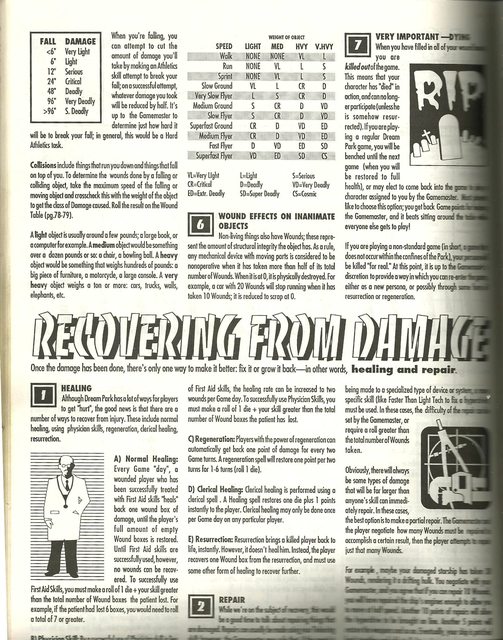
The gravestone is for the bit on dying, the doctor is for healing, the sextant and wrench next to repair- it's obvious and dopey but it helps keep the thing understandable.
The first thing changed from the basic game is initiative. Turns are now taken in order of highest to lowest Awareness skill- if two players have the same skill they either decide among themselves or go by the "closest to the GM's left, then clockwise" bit. I'm not sure if this means the GM goes last, but I'll go with that. (There's no declaration phase, but you can "Hold or Wait", even taking up part of your turn before doing so.)
During your turn you can do any or all of the following: Move, Take an Action, and Dodge.
Movement is now in inches instead of squares, though you can use a square grid anyway. Combat is a 1 inch = 6 feet scale, and you can move up to six inches (36 feet) in a turn, depending on terrain. You can run for twice as much, but only for 10 turns in a row, and if you do you can only change direction three times. If you sprint you only turn once and have to take a rest after. (There's also Battlefield Scale, for big fights, and Travel Scale if you feel you need to make it a hexcrawl.)
Attacking basically works the way it used to, rolling your attack skill vs. Dodge (or Melee Weapon against Melee Weapon), only now things have differing ranges and range increments. The ranges are Melee (1"), Close Range (12"), Medium (24"), Long (48"), and Extreme (72"), and the range listed for a weapon is how far it can shoot without penalty or being forbidden outright. If it's closer you get a bonus. Weapons also have a rate of fire, which is the max number of attacks you can make in a turn. Damage uses a d6 roll on a table now, again cross-referencing the weapon's damage level (rated from Very Light to Cosmic) against an opponent's armor.
Damage now impacts your skills (-1 for every two wounds) and movement, which has a certain death spiral thing I'm not keen on, given that healing magic is limited by the "per Game" thing. The First Aid skill lets you recover one box per day, which is not a lot, and Physician gets you two wounds per day. (The difficulty is 1+the number of wounds lost.)
I'll jump ahead for now to non-combat actions, which give us our basic difficulty scale. Easy tasks are rated at 6, Average at 8, Hard at 10, Very Hard at 12, Extremely Hard at 14. Since the highest skill you're likely to start with is going to be 4, you start out kinda weak here, failing an average task more than half the time. (Remember, you have to BEAT the difficulty, not just EQUAL it.) It's definitely a "start at Level 1" mentality, which is actually at odds with the balancing mechanisms the game brings in much later.
Opposed actions are handled like you'd think- presumably since you initiate, you lose on a tie. The rules could be clearer on this.
Spells and Psionic attacks require you to roll >6 to successfully cast. Ones that require touch use HTH against Dodge, and the target of a ranged attack can Dodge vs. the Skill roll the caster made. Again, though, since Superpowers don't use a roll, they hit everything they point at. Hitscan eyebeams!
Jumping back, there are some maneuvers. They're of the "take a penalty to do an effect" sort- Disarm for -2, amplify damage by two levels for -5, instantly stun for -4, pull a punch for -1, etc. Nothing terribly exciting, and you'll want to wait until your skills have beefed up a bit before trying most of 'em.
You can split attacks, using the ROF rules, but that means you divvy up your Skill- so, if Jenny with her Ranged Weapon of 3 wanted to shoot two thugs, she could use 2 for one target and 1 for the other, and she'd have to use the same weapon for both.
Automatic weapons let you make Autofire attacks which give you a bonus to multiple attacks on targets within an inch of each other, or for suppressive fire on an area no more than 2 square inches. There's no splitting, no penalty, only a bonus. The big disadvantage is this is the one time ammo comes into play- if you use Short Burst for a +1bonus you can make three of those before your ammo runs out. If you use Long Burst for a +3 bonus, you expend all its ammo and better hope there's more somewhere in the game world. You make a single roll that all targets roll Dodge against.
Combined actions are when you try to do from two to four actions that aren't moving or dodging. You divvy up each Skill you use by the number of actions attempted, rounding down.
Finally there are some optional diagrams for chases, races, and dogfights, if the map won't do. The chase/race track is basically one line with twelve spaces before the finish- either the pursuer is overtaken or reaches the finish and escapes, or a racer reaches the finish and wins the race. Since vehicles have fixed movement rates it's kinda dull, though if two participants have the same speed, they both roll a die and whoever wins gets to move an extra space. (This means there's no skill involved, so this isn't a great system for racing. I'd make it Driving / something else relevant and have it work across differing speed categories.) There's a more elaborate chart for maneuvering chases where you AREN'T going in a straight line, and some rules for collisions. On top of all this there's a dogfighting chart, which is actually kinda good- you roll Ploting skills against each other and this decides your facing. If it's a tie neither target is facing the other, within 1 point either way it's Head On, if you beat your opponent by 2-3 you're aiming at their side, and by 4+ you're on their six.
So, yeah, a big glob of rules. In play I remember this running pretty smoothly, but as with nearly all games from this era there's still a bit more cruft than you really need. Having everything revolve around 1d6 makes things kinda swingy, but it's meant to be a fast and dirty kinda game and that works well enough.
Next Time: Game Points & Experience , aka the difference between dead and dead-dead.
Chapter 4: Game Points & Experience or Drew Carey Was Wrong
Original SA post
Dream Park: The Roleplaying Game
Chapter Four: Game Points & Experience or Drew Carey Was Wrong
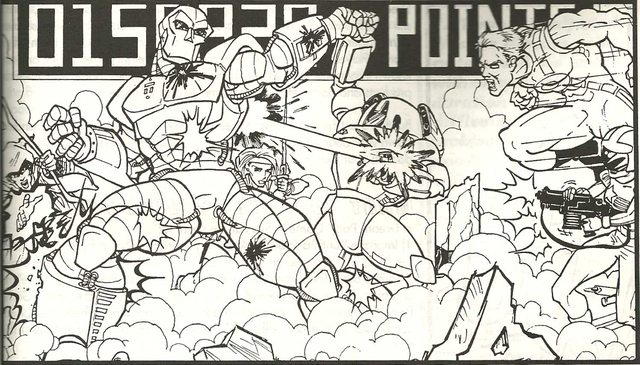
Points! Glorious points! Game Points are your reward and experience mechanic, and they enforce the game-y nature of this… game. You know what I mean. In the books they talk about getting hundreds and thousands of them (There's even a quote where Acacia says if she gets to 2,000 she'll be a Lore Master, a qualification this game doesn't follow), but here points are doled out in more rational increments.
Game Points can be spent to improve your character. Basic Skills can be improved on a one-for-one basis, and any expense there is permanent, no take-backs. The good news is your Basic Skills will never be reduced. You can't elevate any Skill beyond 12 points, and between Games you can only spend 3 of your Game Points on Basic Skills. You can spend unlimited Game Points on Options and gear, using the same costs as at chargen. As I said before, these improvements can be "cashed in" to get points back if you need to move them around between Games. Now, there's a very good reason not to spend as many as you can, but I'll get to that.
You earn Game Points through combats, achieving goals, and through bonus awards. There's a basic guideline for this- humanoid opponents in the book are listed as Grunts, Thugs, Henchmen and Villains in order of toughness, and monsters are Frights, Monsters, Horrors, and Terrors. The toughness of the battle determines the base award, and there are modifiers based on whether the players outnumber or are outnumbered by the enemy- the final score is given to each surviving character. (Yes, you can mix types up- the GM gets some more detailed advice on building combat encounters, though it's not exactly D&D 4e's XP Budget system.) Points for Goals are similarly ranked by toughness. Finally, at the end of the Game, everyone writes down a secret ballot of the characters, awarding every one except themselves 0-3 points. The GM does the same, and each player gets the average of what they were awarded. Finally the GM can also reward stuff like teamwork, skills, etc. with a few Bonus Points.
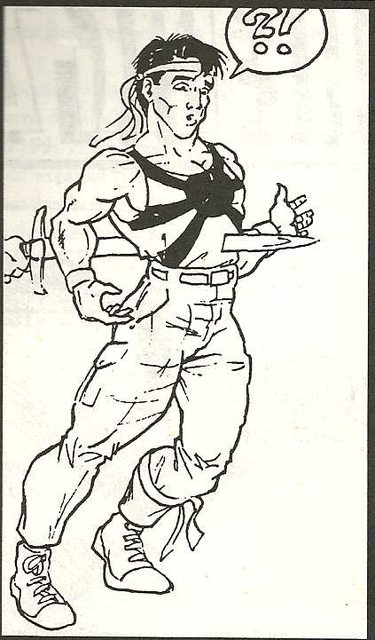
It's possible to lose Game Points, and the most frequent way to do this is by death. If you're Killed Out of a Game, you lose 50% (rounded down) of ALL your accumulated Game Points - i.e., not for this game, but in total. Losing an Option (trashing a spaceship, for example) means you lose the points you spent on that- i.e. you can't cash it in. Finally you can lose points for bad sportsmanship and the like via secret ballot, though really you should just be kicked from the group if you're that much of a pain.
There is a nice codicil to the "Killed Out" clause, though. If there's any time left in the Game (i.e. you don't die near the very end of the very last battle), the player can play a "zombie" and have the penalty reduced to 25% assuming they do their job. In the books this meant actual zombies because they were playing games which involved undead of some kind, but you can end up playing any kind of monster or NPC normally controlled by the GM. The main rule is you have to be ruthless. Your former comrades are now your targets.
Now, here's the reason you DON'T just want to sink all your Game Points in permanent options like skill increases. Normally, a character Killed Out of a Game will come back in the next one, good as new. However, there are three official ways to be killed "Dead-Dead", which means you lose the character (the role, mind you, not the patron) and have to start over with 0 points. One is cheating, but again, you just kick these guys. Seriously, no need to be all passive-aggressive about it.
The second is going below 10 total Game Points. Now, since you start out with none, and you're probably going to get some losses in early games unless the GM takes it easy (note: the GM is not instructed to take it easy), RAW this means that you'll be rerolling a lot in early Games. This is dumb, so I, and presumably everyone else, have decided that this doesn't kick in until you're past 20 Points or so- after you've lived through a few Games, it's only a problem if you spend recklessly and/or are really unlucky. I dunno, this rule needs some tweaking.
Finally, there are Challenge Games, where you can play for point values up to 10x normal, but if you die, your character is wiped. You can even set up Challenge Games with players competing against each other, with the provision that the survivor gets the loser's Game Points. Of course, if they both die, the house wins.
A sidebar talks about the "Dead-Dead" stuff in relation to the books. We saw characters who were Killed Out in Dream Park return in the sequels, and California Voodoo Game clarified the whole "dead-dead" thing. In that book, S. J. Waters, playing an Engineer, talks about how he cheated in the Cyberyakuza Game and was wiped- he had been killed out, came back as a cyborg, but tried to use the in-Game technology to revive his old character and take over the city until he got shut down. The other permadeaths we see are from characters going through NEKRO-seals, which are basically big "don't go here" areas you normally have to work to get through because they're there for security reasons. (The exception is at the end, when a malfunctioning nuclear reactor has to be shut down by someone going through the barrier. Nice dick move, but it's the out-of-game bad guy who gets mind-controlled into doing it. ) The designers point out that they can't really put up Nekro seals in an "in head" game, so they came up with the point attrition thing.
The point is, you will earn points. Some you will spend, some you must hoard to keep coming back- unless you hate your character and want to reroll anyway. This is a short chapter.
Next Time : The Big Zombie Pirate Game! Not as 4Chan as it sounds!
Chapter 7: The Big Zombie Pirate Game or You Can All Swim, Right?
Original SA post
Dream Park: The Roleplaying Game
Chapter Seven: The Big Zombie Pirate Game or You can all swim, right?
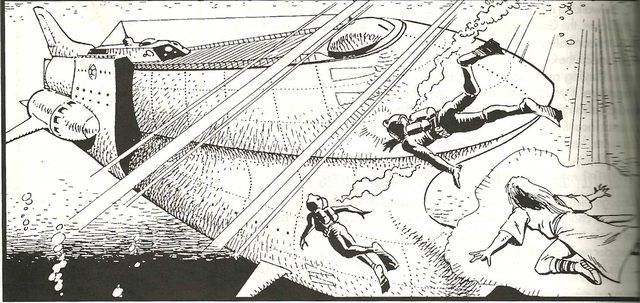
So, Jen Myerson is now Jenny Outrageous, she's joined up with a group, and is ready to go into her first game. She doesn't know much about it, because that's the idea- Dream Park tells you as little as you need to know about each scenario going in, namely, the name of it (which, by tradition, is accurate but misleading), and the basic restrictions on character Options. This time around, no Weapons above Modern, no Necromantic spells, and no Superpowers. None of that affects Jen any, so she's ready to go! Zombie pirates, eh?
The game starts in the Ready Room, which is actually a mobile platform that carries the players (six this time) to Gaming A or B. (It's set up so that the people inside can't feel it moving.) The GM enters, and it's Loren. Just Loren, I guess. Six feet tall, strong build, dark skin, short, curly hair, and a booming voice. He acts very enthusiastic and hopes they'll have fun, and, again by tradition, allows the players to ask him three "yes" or "no" questions about the Big Zombie Pirate game, which he has to answer truthfully.
Howard Sands is the group's Loremaster. He decides to ask the important question, "If I get bit by a zombie, would that mean I get infected and turn into a zombie?"
"No," Loren answers. The players breathe a little easier.
Phyllis "Pizzazz" Gabor is the group's Fighter/Thief, because someone thought the Multiclass looked attractive. "Do we get bonus points for betraying/killing off our fellow players?"
"No, unless you're coming back as a zombie. And stop asking that question." Howard glares at her. She sticks out her tongue and pouts.
A silence falls over the room, and Jen decides to end the session with, "Are we pirates?"
"In a manner of speaking, yes."
As Loren heads to the exit that will lead him to the GM chair, he turns to the group. "By the way, you can all swim, right?" Then he's out the door.
Uh-oh.
To kick things off, the big outer door of the Room opens, revealing… water. There are some fish floating by, and a coral reef is lit by light coming from the surface, forty feet overhead.
We're instructed to let the players freak for "exactly ten seconds" before the transparent barrier snaps back, flooding the room. At least one player notices a pile of aqualungs just beyond the doorway, so everyone has to scramble to put one on.The book describes this as a "Simple Task", which I guess is supposed to be "Easy", and there's no skill mentioned for it, so I'll say Athletics. Sloppy editing! Each turn you fail to don an aqualung means one Wound of damage. Jen rolls a natural six, so she's safe. The point isn't to kill the players outright, but still, I think we can all draw one conclusion from this: Loren is a dick.
Now, this part always stopped me because I don't know how you could simulate this in a Park situation without the risk of actually drowning people. I'm going to assume, then, that it's the funky water-you-can-breathe-in from The Abyss , and they can afford to fill a lagoon with it because this is Dream Park.
Anyway, once the players reach the surface they're pulled up onto a racing yacht loaded with anti-tank guns and flying the skull and crossbones. Captain Jack Hawkins, master of the free privateer Arabella, asks them if they found the sub. What sub? Well, here's Loren being a dick again- Hawkins is their Guide, the person to introduce them to the setting, but he's a gruff salty type who will be really confused by players asking what year this is and where are they and so on. He'll even put them in the hold if they act too crazy, and that's stupid.
So Howard tells everyone to clam up and they just take a friendly look around. They can find out from some investigation (including a couple of skill checks, but thankfully not all info requires them) that it's around 2021, after some big war, and the Arabella is looking for a wrecked Soviet (!) sub carrying the vaccine for a rare bioengineered plague- a vaccine that's worth 10,000 money units and safe haven in the Cuban Republic. They know the sub is located in a lagoon between two islands (marked "Skull" and "Bones"), and they're racing Wolf Larsen, captain of the Seawolf.
Hawkins is about to ask the group to make another dive when the Seawolf shows up and tells Hawkins to surrender. This is a "Confrontation" Cliffhanger but the players don't get much choice- the Seawolf outguns the Arabella two to one, and it'll take a Very Hard Persuasion roll to convince Hawkins to risk the ship. However, the Arabella is very fast, and it can easily move down the lagoon out of range, in hope that they find the vaccine in time to escape with the high tide.
Soon enough they can easily see the submarine lying on the reef. It's been broken in two and sharks are swarming around the breach, but there's a forward hatch they can enter- and of course they've got aqualungs. Unfortunately nobody is perceptive enough to notice another dark shape slipping into the water nearby
Amidst a bunch of dead crewmen, the players find the canister with the vaccine in plain sight. Everyone feels the ka-ching of a Game Point award. But Jenny notices the bodies are a little more… fresh than they should be for having been underwater for years. As they go through the Bridge, back to the forward hatch, the Russian Captain looks up and smiles.
There are two more zombies than players, so 8- plus 5 more up top if the PCs try to get out the way they came in. If the PCs head for the breach, they find the sharks are frenzying over a zombie and can get by easily enough. Still, never let it be said that this team passes up an opportunity for Game Points- these are all grunts who do Light Damage at most, and there don't seem to be any pesky "guns don't work underwater" rules, so there's a good old zombie fight and nobody gets hurt too bad.
But the they get out, and DO notice the dark shape heading towards them.
Zombie shark?
No.
Zombie Kronosaur .
Forty feet long, armored skin, does a potential 12W with its bite, and yeah, this is a fucking monster. It will attack until it's killed and eaten one of the players and it's a potential one-shot kill. Loren is a dick, but the players have a chance. Jenny decides she'll make like The Shadow and cast Mental Illusion to make the Kronosaur think it doesn't see the players. Let's say she succeeds. Unfortunately, the Kronosaur may not be very smart, but it's got a 3 Willpower (why I have no idea), and successfully resists the illusion. The beast grabs a hold of the team's Engineer, Rio! He drops the canister, and Pizzazz takes it. In a last ditch sacrifice, Rio shoves his aqualung between the monster's teeth just before it swallows him whole. His valiant last words- "Smile, you son of a bitch!"
The monster swims away, almost out of sight.
And then it explodes.
Down to 5 people, the party doesn't have time to mourn. They reach the Arabella in early evening, and though they got the vaccine, things are too still, and a mysterious fog is rolling in. Then they hear, across the lagoon, screams, gunfire, and roars coming from the Seawolf. The tide's not quite high enough to leave, Hawkins figures it's against the law of the sea to let even your worst enemy get eaten by undead horrors, so they sail over to the boat.
By the time the players get to the Seawolf, it's adrift, and bodies are piled in corners. Nobody is alive. Then the ship's cat, soaked in blood and mewing, walks out. Feeling sorry for the poor beast, Jenny pats its head. Which falls off. And keeps meowing.
It's a good idea for the players to leave before the rest of the crew… wake up, but Jenny, finding the kitty harmless, takes it along, remembering the head too. She asks Carmen, the team's Medic, to stitch it back in one piece. This is totally pointless but she just thinks it's cute, even as an undead abomination.
Then the ship is attacked by three elasmosaurs, who with their long necks can pluck anyone off the bridge if they please. These guys aren't as bad as the Kronosaurs, though, and the Arabella has anti-tank guns. It's a fight to the death! Pizzazz deals some heavy damage to one with the cannon. Kimber, a magic-user, finishes another off with fire spells before being snatched. Jenny uses her last Illusion to make an Elasmosaur snatch up a drum of gasoline instead of her, and Howard makes sure to move the ship a little before Jenny fires her pistol and ignites the gas, killing the remaining critters. Down to 4, but more Game Points for all!
(If any Players stay on the Seawolf, Kronosaurs are lurking nearby ready to snatch anyone who gets too close to the side.)
Lying exhausted on the deck, the players hear the sound of drums. (It's an Average Awareness roll but there's literally nothing else to do.) They see a campfire on the island. It could be dangerous… but they can tell that more things are swimming around. Land may be their only hope. So they go on shore and find themselves wandering through a deserted jungle… to a large clearing, with a small white house on the far side, with drumming playing over loudspeakers. The home of the Zombie Lord. Between them and the house, around a bonfire, are a whole bunch of sleeping Zombie velociraptors. Six of 'em.
(Meanwhile, underground in Gaming Central, Rio and Kim get set up on robot control consoles. Time for them to mow down their fellow players and get some points back!)
Pizzazz's Stealth is pathetic because she picked the worst option, and nobody else is terribly good either. They try to circle around the clearing, but the raptors have their scent already, and Howrd tells them to make a break for it. Jen provides some covering fire as Howardheads to the house, desperately, with Carmen running along, also firing and ready to Cure Howard if necessary. Jenny makes an Emotional Attack to charm one of them, and it snaps at another. Pizzazz, a little weak on strategy, tries to make a stand with her nifty anti-tank rifle. She guns down two before a third tears her down. (Down in Gaming Central, Kim and Rio give each other a high-five.) By this point the Zombie Lord has noticed the commotion and approached the front door. Howard, Jenny, and Carmen can all see he's about to do some kind of mojo. (He's got Deathword prepped.) Not sure three non-combat types can take this guy, Jenny casts Emotional Attack- LOVE!
The Zombie Lord reels for a bit- he resists the spell, but he's shaken. He rears back, holds his hand up. The raptors stop nipping at their heels. "Who are you people? What are you doing here? It's dangerous!"
It turns out, the Zombie Lord is not a bad guy. He was a paleontologist at the University of Chicago, working in the Carribean when The War came. He dabbled in Voodoo and decided that if mankind was gonna screw itself over, the land should go back to the dinosaurs- so he used his voodoo skills to bring dinosaur fossils back to life, and populate Undead Jurassic Park. However, the spell he has going also reanimates other dead things, like, say, pirates and kitties.
Howard explains that they're sailors trapped in the inlet and trying to escape. The Zombie Lord invites them in and explains himself, and while he's disappointed that they killed so many of his creations, he has to admit, they're not at fault. The raptors, at least, will patch up easily. He offers to re-animate the party's dead, and they decline as politely as possible. He then says he'll control the remaining aquatic monsters long enough for the Arabella to leave. And he proudly shows off a Zombie Allosaur he intends to have up and running by tomorrow night.
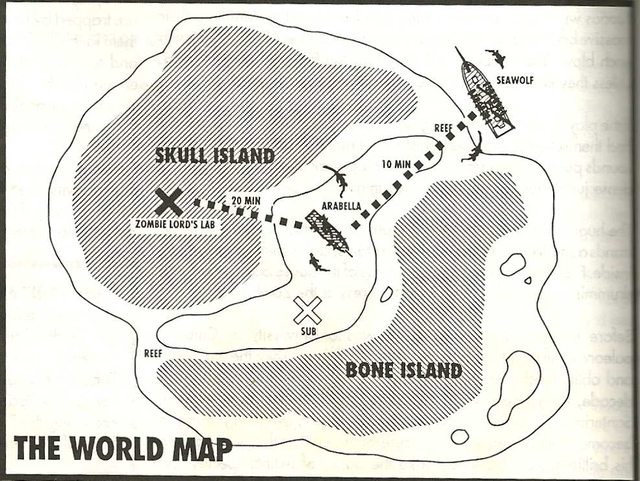
The Party has won! The Arabella sails to the edge of the dome, and the Players are escorted off. The awards here a little nonstandard, and divided among the players:
Surviving the Sub Zombies- 6 (so is fighting them a waste? I call foul!)
Getting the Cannister- 5 (I'll just round it up to 6 because why not)
For each Elasmosaur killed- 8
For each Kronosaur killed- 10
For each Velociraptor killed- 6
Killing the Zombie Lord- 8
For making Peace with the Zombie Lord- 12
So, Jen gets 2 for the Sub, 2 for surviving the Kronosaur (10/5), 6 for the Elasmosaurs (24/4), let's say… 6 for the Raptors (we'll say they took one down in addition to Pizzazz's two), and 4 for making friends with the Zombie Lord. In addition, she gets voted 2 bonus points for helping the team get the best ending. So, 22 Points already! Poor Rio gets the lowest overall score- he had 2 Points for the Sub, lost 1 for being killed, got it back for playing a raptor, and was voted 3 by the party and an additional 3 by the GM, so 8. Again, it's his first game, we'll let him live.
Jen already knows one thing she's going to buy with her Points. It's a small expense, just 2 points- Small Fuzzy Animal Companion.
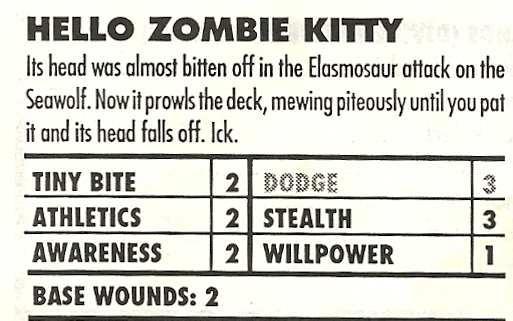
She'll call him "Stitches."
Next Time: Writing Dream Park Games!
Chapter 8: Writing Dream Park Games or It's Die Hard on a steam-powered spaceship!
Original SA post
Dream Park: The Roleplaying Game
Chapter Eight: Writing Dream Park Games or It's Die Hard on a steam-powered spaceship!
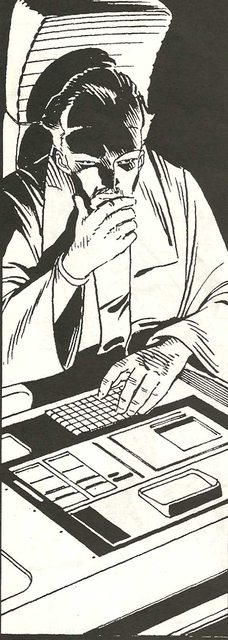
So enough of looking at this from the player end! Let's climb into the big chair and see what we can do with this game. Writing your own Games is… well, almost necessary since only three modules were ever published (I own two and will cover them if there's any interest). Fortunately it's also a lot of fun and they give you a lot of help doing it. You end up with Games that are kind of railroady, but that's sort of in keeping with the books, and nothing really stops you from making things more open and sandbox like.
The first thing you need is a name. (Well, I'd suggest this for later, but they put it first.) All Dream Park Games are formatted as The ______ Game, as seen earlier. The tradition is to make the name a little misleading. The Big Zombie Pirate Game doesn't give any hint as to dinosaurs. In the first book, The South Seas Treasure Game was largely about Melanesian Cargo Cults. The Fimbulwinter Game in the sequel ended up focusing on Inuit mythology, and The California Voodoo Game had a healthy slice of Von Danniken's Chariots of the Gods alongside the Santeria.
(Yeah, you'll notice all the books had a lot of mythology going on. The game and its supplements don't get into this, mainly because it does involve a lot more research and work, but nothing's stopping you.)
The game's big hook is that it's a "Meta-Genre" system, which is not really a thing, but according to them it means that you can mix together various genres instead of running through them one at a time. There's a big list of genres, each listed with examples and "rules", and you pick and choose which ones go together. For example, the Zombie Pirate Game had Horror (zombies), Pulp (Lost worlds, dinos), and Swashbuckling (pirates). You pick out some rules and figure out how these elements will be revealed to the players- again, in our example Game, the first couple of scenes introduced the pirate angle, then we met some submarine zombies, and then a big old zombie dinosaur showed up to introduce the prehistoric element. You should also set a Goal for the game- something the players do to win, like rescuing a prisoner, finding treasure, defeating the monster, saving the kingdom, etc.
The Game gives us 12 genres, promising more in future supplements (this never happened.)
-
Fantasy
. Your standard Dungeons and Dragons, Western European sword and sorcery stuff. Rules may include "Magic is always Good or Evil", "There are always Powerful Artifacts that must be quested for", etc. But this can also be used as a pretext for any kind of fantasy from any culture.
-
Horror
. Zombies, vampires, serial killers, etc. Rules include "Zombies are killed by fire or hacking them apart" (I guess headshots are a little too much to ask), "Vampires fear the light, sleep by day and can be killed with a stake through the heart", etc.
-
Swashbuckler
. This is basically anything Errol Flynn ever did- pirates, the Three or Four Musketeers, Robin Hood, etc. Rules include "Villains and Heroes always settle things with one-on-one duels", "swords are preferred over other weapons", "Cowardice is the ultimate sin", etc.
-
Western
. You know what a Western is. Heroes and Villains always have showdowns, Villains have no honor, Cowardice is again the ultimate sin, etc.
-
Victorian
. You may argue that this is more a time period than anything else, but it's nice flavoring. Honor is important, the Queen is revered, technology will conquer all, female sexuality is dangerous (they don't include this one), etc.
-
Cyberpunk
. They actually use the CP2020 logo for the "Cyberpunk" name, because of course they can, being R. Talsorian. Even though the books kinda verge on Cyberpunk-level technology, this pushes it further into the future. Jenny's home. Rules include "No one can be trusted", "All corporates are treacherous", "Metal is better than Meat".
-
Gangster
. Mostly roaring 20s type stuff, with tommy-gun wielding hoods battling G-Men. "You must belong to a Mob or the FBI", "G-Men are incorruptible; politicians are not", Never Get High on Your Own Supply, Just When You Think You're Out They Pull You Back In, etc.
-
Pulp
. Pedants will note that "pulp" in its classic sense is something that modifies other genres already- Mystery, Adventure, etc. Whatever. It means there are crimefighters, lost worlds, Nazi bases, etc. Villains always want power, Civilians must be protected, there's always a Master Plan to defeat, etc.
-
Superhero
. Everyone gets costumes and secret identities etc. Rules are like the Pulp ones.
-
Space Opera
. Spaceships! Aliens! Lasers going pew-pew-pew! The rules are things like "Most Empires are Evil", "Psionics replace Magic", "Most Aliens are humanoid", "Female aliens always fall in love with human males".
-
Espionage
. Spy agencies battle it out for information or control. The rules suggest this can range from Avengers-level heroics to something more like the Le Carre novels.
-
War Story
. Fighting men and women in combat! This seems to reference actual historical wars, but in theory it's a general approach you can use for other genres.
(Short note here- the game, in mentioning several possible combinations, has an early example of "Steampunk" used as a word. It was the first time I ever encountered the concept, though it wasn't really new.)
Then you set the limits- first is "Player Level Limits", for the total number of Game Points each Character has. Logically this should just be how far along your group is unless you want to start higher. Historical Limits and Power Limits are also what we saw in the last chapter- you can say "no weapons above Modern" or "no Psionics". You have to tell these limits to the players beforehand so they can adjust their Options accordingly.
So, study the list above. I want suggestions! I'll take us through the process of writing up a Game story and show off some things that way. I have a couple of ideas but as this write-up has shown so far, I'm open to better ones!
Next Week: Scripting the Game , in which we lay down fat beats!
Chapter 9: Scripting The Game or Don't You Let The Beat Drrrrop!
Original SA post
Dream Park: The Roleplaying Game
Chapter Nine: Scripting The Game or Don't You Let The Beat Drrrrop!
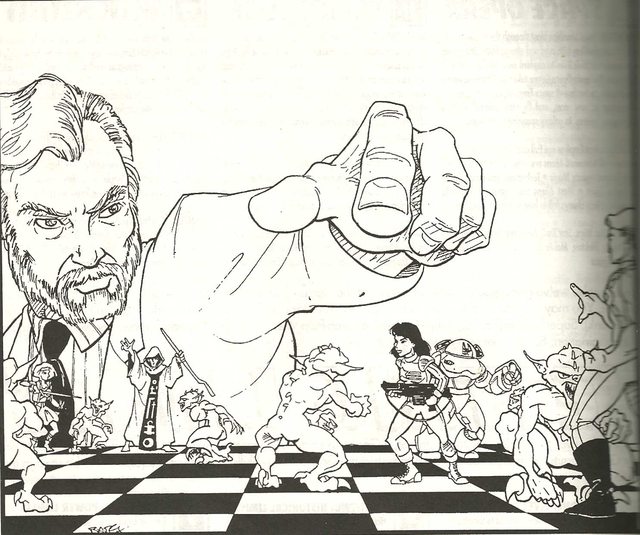
This chapter centers around The Beat Chart. A Beat Chart is basically a rough summary of what will happen in the Game, broken down into Beats. You start with a Hook, alternate Cliffhangers- dangerous action scenes- with Developments- non-action stuff, plot developments mostly- and build to a Climax and Resolution. I said Dream Park Games are often railroady and linear, and this is a good example, but it works. The book actually gives us two examples. One is the Beat Chart for a hypothetical episode of a TV detective show. Luger, P.I. finds the body of an old friend clutching a book, he fights some thugs, finds that the book is important, the thugs kidnap his girlfriend, etc. Another is a hypothetical GM putting together a Game- the characters find a mysterious ring in a tavern and get told by a wizard to destroy it, but he's actually lying about it being evil, blah blah. The major rule is you never put two or more Cliffhangers or two or more Developments right after each other- you always want to alternate action with plot.
What follows are a bunch of suggested specific Beats, most predictable, but with a few neat ones (the Coronet Blue Hook, based on an old TV show, has the characters all wake up in a dangerous situation with no memory of who they are or how they got there- but of course their enemies and friends think they know the score.)
So! I asked for a few Genres, and I got Victorian, Swashbuckler, Space Opera, Fantasy, Pulp, I think Cyberpunk was in there somewhere, so naturally it took me a while to synthesize it all.
So, The King of the Moon Game is a Victorian Space Opera with Fantasy, Pulp, and Swashbuckling elements (couldn't quite fit in Cyberpunk). No weapons above Historical, probably no Superpowers, and I'll say Psionics are OK but you have to call yourself a Mentalist and dress in weird robes and such.
Hook : Kidnapped ! The characters are on board for the maiden flight of Her Majesty's Airship Plymouth, a high-altitude pressurized craft invented and piloted by Professor Chadwick. In attendance are a number of influential businessmen, scientists, etc. Suddenly, the ship launches ahead of schedule, soaring into the stratosphere, straight for the moon! A voice crackles over the loudspeaker, that of the deadly, anonymous crime lord Magus Magister!
First Cliffhanger: Obstacle - the ship will crash on the moon if the players don't do something! They can't steer the craft to Earth but they can guide it to a safe lunar landing.
Our first development is a Warning . Professor Chadwick now knows for certain that Magus Magister must be on board- and he's almost certainly one of the invited guests! I'll leave time for plenty of wild accusations and outraged denials.
Then, our first Battle! The game suggests you space out the battles in ascending order of enemy power- first Grunts, then Thugs, then Henchmen, finally Henchmen and Villains. So for our first fight, a group of Moon Elves (Grunts) lay siege to the craft! The players should be able to fight them off easily, but at least one of them will get close to the guests, cast a strange spell, and vanish!
This necessitates a Hazardous Quest! The characters must track across the lunar wastes in pursuit of the captives, past treacherous Moon Bogs and swarms of Lunar Mosquitoes- minor action beats, up until-
Monster! A space dragon! Creatures have a similar power curve, from Fright to Monster to Horror to Terror, but since we're well into the Game now we'll make this a full Monster.
Alliance - Having defeated the dragon, the players, now in the Tycho Forest, meet with Robinod, leader of a group of rebel Moon Elves fighting against the evil Elves and their cruel, masked master.
Battle! - Thugs raid the rebel encampment. After the fight, the players and the rebel elves can easily track the thugs back to their city, where-
Revelation - A giant Arcane Lens is pointed at Earth, sitting atop a fortress with the Magister's mark over the entrance. Magus Magister has been on the moon before, and if the Professor is with them he can surmise that the arcane energies of the moon could easily be focused through the lens to create a beam of destructive power!
Obstacle - The players have to infiltrate the fortress. Sneak by or subdue guards, avoid setting off alarms, that sort of thing.
Clue - The players will eventually make their way to Magister's lair, which has clues to his identity- it reveals that he has been to the moon before via an arcane portal long since shuttered, and he needed to come back to complete his plans. They find drawings of the Lunar Lens and any more information that needs to be there.
Obstacle - Of course, then the door shuts and poison gas starts to fill the room.
Villain's Monologue - Another loudspeaker, and Magus taunts the PCs. With the power of the Lunar Lens he can lay waste to the Earth's major cities and turn its population into helpless slaves, just like the strange and fantastical moon creatures! (This happens while they're finding their way out of the poison gas trap.)
Monster - A Horror this time, a giant villainous moon ogre guarding the entrance to the lens control chamber.
Puzzle - Once the ogre has been dispatched, the players must unlock the door to the chamber. The lock is a series of lunar runes, and only by pressing those which spell Magister's true name can they enter. His true identity? If they put the clues together they will discover that he is Chester Blake, the cigar chomping millionaire robber baron and secret occultist, who went missing for around the same time that Magister made his first lunar trip.
Once they make their way into the chamber- holding the chained forms of the other airship guests in preparation for a sacrificial rite- it's time for the Final Battle ! In keeping with Victorian and Swashbuckling virtues, Magister/Blake must be defeated in a one on one duel, while the other players, alongside Robinod, battle the evil elves and disable the machine before it's too late for Earth!
The resolution- let's say Villain Escapes . Magister's plan has been foiled, but the hero fought an arcane mirror image, and the real Magus Magister escapes into the sky in a personal gyroscope! The players can get off the Moon once Chadwick fixes his ship, but killing or capturing Magister will have to wait for another Game.
It's just that easy! Sure, it took me forever, but I wanted to stick to listed Beats, and once you get the hang of it it's a fun way to assemble a game plot. It does limit you to mostly linear stories, but you can put a lot of freedom in individual Beats. (Infiltrating the fortress, for example, could be done any number of ways, as could tracking the captives, working out Magister's identity, etc.)
Next Time: Mapping the Territory and Lights, Camera, Actors!
Chapter 10: Mapping the Territory or Mornington Crescent!
Original SA post
Dream Park: The Roleplaying Game
Chapter 10: Mapping the Territory or Mornington Crescent!
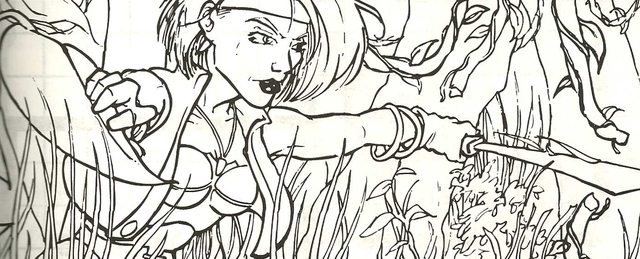
This short chapter gives you a fairly interesting quick method for drawing up a map for your Game. (Most of the chapters now are pretty short so I'll end up bunching a few together.)
Dream Park has two giant domes (later modules would add a third, just 'cause), and the major suggestion is to think of them as "worlds"- islands full of locations that are relatively accessible to each other, with travel between the "islands" usually requiring some more elaborate device (getting the players on a spaceship or having them go underground, etc.) So you draw a couple of big circles for the "worlds" of your game, and draw smaller circles with lines between them for individual locations, and you note how long it takes to get from one location to the next in a general sense. Like so:
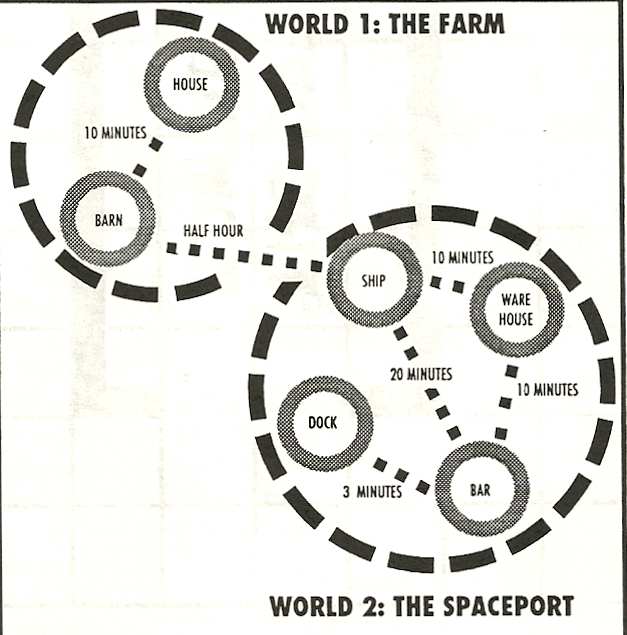
You then place the beats of your script at various points on the map, trying to use everything at least once. This can help break up the linearity of the Beat Chart as well- it's possible now to backtrack or bypass things or place them so they can be encountered in a different order.
Now, The King of the Moon Game probably only needs one "World"- we spend a bit of time on Earth getting into the Airship and all, but that's basically all stagecraft, the players aren't free to wander just yet. The ship, the moon forest, and the city and fortress can all be relatively close together, and most of the travel will be on foot. I'll want to break up the fortress into different locations (the villain's lair, the entrance areas, the chamber for the final battle.)
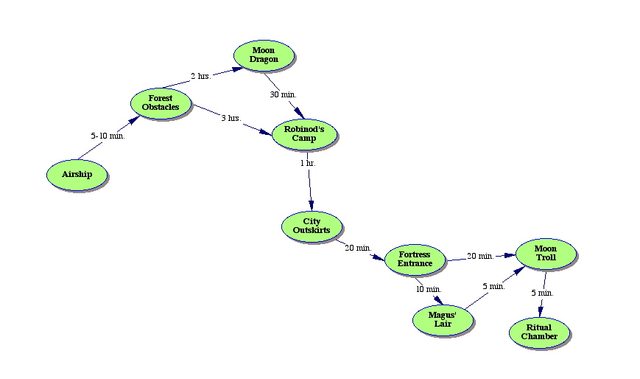
(This could probably be even more detailed if I ever sat down and worked out just what all the forest obstacles were.)
And the final part of this chapter is just drawing up detailed maps for individual "sets", which is the standard drawing walls and doors on graph paper stuff. Necessary for the game but we all know how it works.
I'm actually thinking I'll steal the Beat Chart and Mapping stuff for other games too- when making a D&D dungeon I usually have a little trouble just drawing a bunch of rooms and having it be an inspiring structure, so working from "here's this encounter, here's this other encounter" will probably give me a better sense of things.
Next Time: Lights, Camera, Actors! and Scaling Your Actors , in which we get two entirely different ways of statting NPCs.
Chapters 11 & 12: Lights, Camera, Actors! and Scaling Your Actors, or The Entire Party Was Eaten by a Small Dog
Original SA post
Dream Park: The Roleplaying Game
Chapters Eleven and Twelve: Lights, Camera, Actors! and Scaling Your Actors , or The Entire Party Was Eaten by a Small Dog
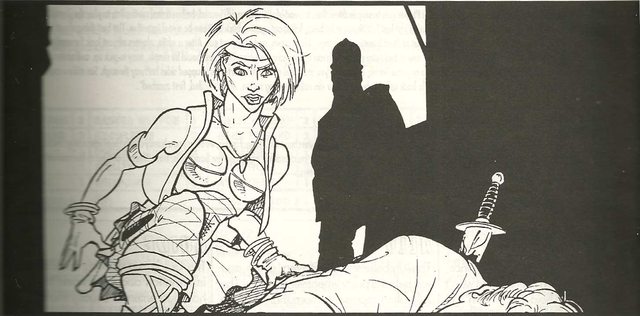
Now that we've set up locations, it's time to get down to casting our NPCs. This chapter is largely a listing of 24 stock NPC templates, all using the same format as the character cards and Profession listings, giving us their basic skills and wounds.
Some are just plain redundant; the Evil Enemy, Likeable Enemy, Logical Enemy, and Psychotic Enemy have the same stats, it's just that they're respectively Darth Vader, Tarquin, The Rani, and The Evil Midnight Bomber What Bombs at Midnight. Others try to match mechanics to personality (the Zealot has a 5 Willpower), and others are interestingly balanced- the Ambivalent Ally has better stats than the just plain Ally, the Dangerous Lover can take care of themselves while the Helpless Lover is there to be captured, and the Dangerous Ally has good combat skills but terrible Stealth and Awareness- essentially Leeroy Jenkins. The "Sage" character has two "Subprofessions" listed, Medic and Priest, and is the only one with those, and I guess the implication is that this character could also be given healing abilities. We also get base stats for the various categories of NPC goons (Grunts, Thugs, Henchmen) and monsters (Fright, Monster, Horror, Terror). There's also The Neutral, Zapp Brannigan's eternal nemesis.
There's also some basic advice in this chapter- giving Actors and Villains quirks and motivations, the use of Guides, and creating Zombie parts- like the Velociraptors in the Big Zombie Pirate Game (they don't have to be undead, just non-key NPC roles). The last section advises setting aside no more than two Actor Roles for potential Zombies, on the grounds that otherwise "you may find your entire party has swapped sides halfway through." This doesn't make any sense since that would mean a TPK has happened, so fuck that. As many zombies as necessary.
Now the thing is, while the roles presented are a nice selection, they're balanced against starting PCs, and to actually keep up with your players as they improve, you'll need the next chapter, Scaling Your Actors .

This chapter introduces the Sliding Scale, which is an interesting early attempt at tailoring enemies to the PC's capabilities. (Storygame bullshit! Magical tea party! Where's my immersion?! Etc.) It requires that you average the Basic Skills of the PCs, and then build their enemies by adjusting those averages. Grunts and Frights will generally have combat skills 1-2 points lower than the party average, Thugs and Monsters will be equal, Henchmen and Horrors will have a 1-3 positive modifier, and Villains and Terrors will have an advantage of 3-5.
The example given applies this to all four of the Basic Combat skills equally, so if the party Average for Ranged Combat is 4, a Grunt will have 2, Thugs 4, Henchmen 6, and Villains 8.
Specific skills- options, spells, etc. are decided more on a case by case basis, and generally are a little better than the players- so if the party has spells of around 2-3, the villain might be able to cast at 3-6 (which lines up pretty well with the Zombie Master's stats in the Zombie Pirate thing.) Wounds for human-like NPCs should generally be around 1d6+6, while monsters use a system based on the party's average wound total.
This was an eye-opener. I'd never really seen anything like this in other games, which assumed that you'd pick the villains from a list and hope that it wasn't a cakewalk. It may not actually be without precedent but it's definitely ahead of its time, and it is a time-saver. The major drawback is that of all scaling systems- the players may not feel like they're actually getting better if their enemies improve so closely with them. Plus it makes the templates useless, for enemy NPCs at least. As presented it can be a little bland, though it doesn't say you have to apply the modifier to all abilities equally, so there's room for fine tuning.
Another method presented is "Build By Points". Basically you pick out all the templates for ALL the actors who will be in your game, and then take the total Game Points of ALL the players in your group, and use that as a pool to buy Options and Basic Skill improvements. It's not quite clear from this whether you use just the unspent Game Point totals the characters have on their sheets, or all the points they've been awarded, and either way it's a lot more involved. And the game points out that this method does make it possible to create frustratingly overpowered characters, and that you should use caution with it.
Neither method seems entirely satisfactory to me but the Sliding Scale seems like a good quick solution, with some tweaks here and there. The modules, however, introduce a more sophisticated version which allows for better customized characters.
Next: Four short chapters, including Props, a rundown of the Dream Park novel's South Seas Treasure Game, and general GM advice on Setting the Stage and Running the Game! It's not quite the end but I'll run through it quickly anyway.
Chapters 13-16: Props: Goodies, Gadgets and Stuff, The South Seas Treasure Game, Setting the Stage, and Running the Game or Let's Just Get Through This
Original SA post
Dream Park: The Roleplaying Game
Chapters Thirteen through Sixteen: Props: Goodies, Gadgets and Stuff, The South Seas Treasure Game, Setting the Stage, and Running the Game or Let's Just Get Through This
I apologize for taking so long with this one, but it's kind of a grab bag of stuff and it's pretty slight. None of these chapters takes more than two pages.
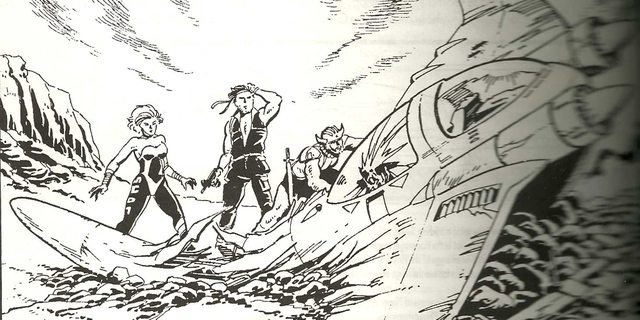
The chapter on props is basically dullsville, essentially one page noting that you can use the "Gadgets and Gear" section of the Options chapter to introduce and decide point values for any in-Game objects, vehicles- there are even modification rules, so it's just a question of figuring out how many Game Points they're worth. The same can be done for pets and vehicles. If you want to give a sword a spell-like ability or somesuch, you can simply use the various spells in the Options chapter and add those. There follow the standard caveats about creating anything too powerful to be taken across Games, and you can make certain things one-shot props. Nothing too special here.
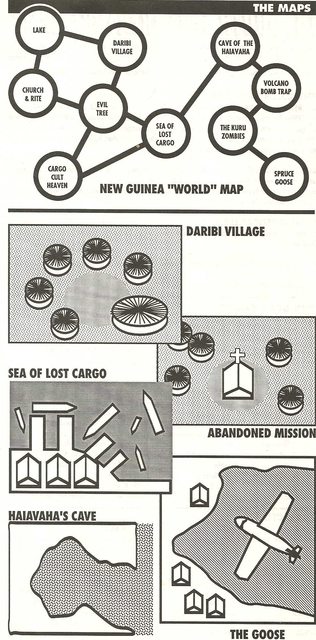
The next chapter is "The South Seas Treasure Game", which very briefly breaks down the Game featured in the original Dream Park novel into the Beat Chart and world map structure. (No room for NPC stats, sadly.) The Game is based on the Melanesian Cargo Cults that sprung up around World War II- these guys, seeing soldiers lay down airstrips for planes to drop off food and guns and so on, decided to copy these mysterious ground patterns to "summon" the creatures from the air and receive their bounty. In this world, it actually works, and someone managed to call down a key piece of technology, the absence of which has stalled the Allied victory in the Pacific. The party has to fight jungle monsters, laughing Kuru zombies, and a giant monster called a Haiava, as well as rescue a damsel, beat the Cargo Cult god Yali in a riddle contest, and survive a particularly nasty GM trap. There's a sidebar which describes the adventure in full, minus all the out-of-Game intrigue of the book.
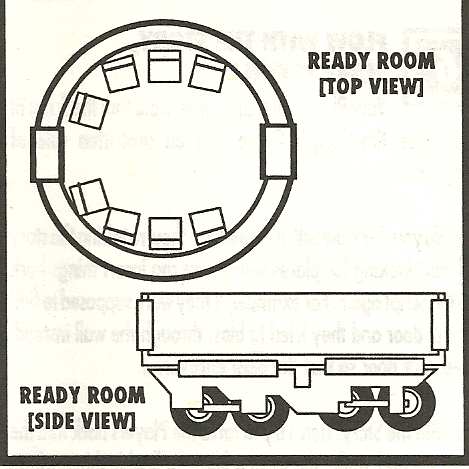
"Setting the Stage" talks about how Games begin. All Games start in the Ready Room, a mobile staging area that actually takes the players to the Gaming Dome. (The California Voodoo Game was different because it was in a partially-abandoned arcology, but never mind.) There's a "sneering Gamemaster" scene, where the players meet the Gamemaster- they can be sympathetic, arrogant, or whatever, but the point is they all have the attitude that you're all gonna die horribly and they're the best at this. You're advised to come up with different GM's with distinct personalities, and alternate between them (sort of like the DJ's in XCrawl.) This chapter also points out that the GM can actually communicate with the players during the Game over their headsets, which can be used for more dickish taunting. Then there are the Three Questions, which the developers admit aren't in the books but are a good tool- it kicks off the players acting together as a team, deciding what to ask and agonizing over the precise wording since they have to be "yes" or "no". Finally you're expected to start with a bang, something that instantly takes the players out of prep mode and into the Game, like the faux drowning in the Big Zombie Pirate Game.
"Running the Game" is general GM advise. Be tough but fair, take notes, keep up the pace, etc. It even says you can cheat in the players' favor if a minor screwup threatens to end everything or bring the game to a crashing halt- this is now a very contentious issue among grogs and non-grogs, but I favor this approach. "Never kill a player on something inconsequential." The one distinct bit is the mention of the real-life International Fantasy Gaming Society, which still exists now and is involved with administrating live action roleplaying events. They do this by way of suggesting you should find a beta reader of some kind for your adventures before you run them, so you can get feedback, just as the fictional IFGS looks over the Dream Park Gamemasters' creations.
Next Time: Taking the Park Out of the Park and we wrap up the core book!
Chapters 17-18: Taking the Park out of the Park and Dream Park Goes Multidimensional or It's a Floorwax and a Dessert Topping!
Original SA post
Dream Park: The Roleplaying Game
Chapters Seventeen and Eighteen: Taking the Park out of the Park and Dream Park Goes Multidimensional or It's a Floorwax and a Dessert Topping!
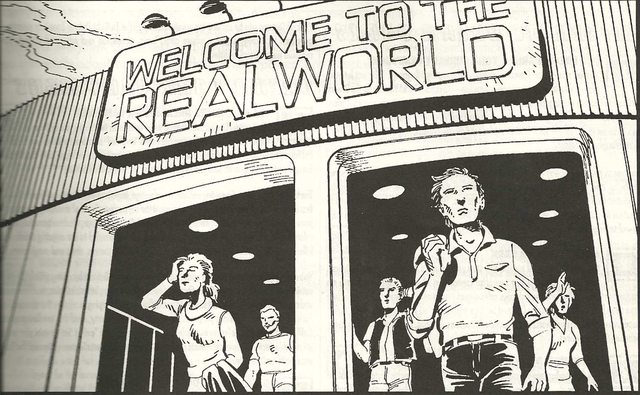
To finish things off, the designers start talking about how the Dream Park system can be used in different ways, if you like the system more than the setting. They try to sell it as a "complete multigenre system", which I guess it is, though it's quirky enough that I wouldn't treat it as fully generic.
First up, alternate forms of Dream Park! You can drop it in your current campaign setting, assuming it's modern/futuristic- the PCs take a vacation and you get an excuse to run something else while you try to figure out how the Hell to repair the damage they caused your original campaign. For older settings, you could have a Magical Dream Park run by wizards and illusionists, with the heroic Sir Alex of the Griffin maintaining security. Aliens could also set one up to torture/study humans, for entertainment or for SCIENCE! Of course it can be a Holodeck too.
The most interesting idea here is The Park of Dreams (written in "scary" font), presented in Twilight Zone speak:
quote:
Presented for your Gaming amusement. A shifting reality in which your dreams are REAL. An island in time and space, where anything can happen, as lucid dreamers shape reality and entrap others in their cunning webs of illusion. Game rules can be looser, and reality becomes abstract, as you enter (if you dare)- The Park of Dreams!
Basically each Game is a new Dream, players moving from reality to dreamland to do stuff. Of course, this is summed up in two paragraphs so if you want to develop it further you're on your own.
They give a few ideas for Dream Park campaigns as well. First up, there's some talk about the "Multilevel" Dream Park campaign, where it basically becomes like the novels- the players play the Game, but also get involved with intrigues and industrial espionage in a near future setting. It's an interesting idea and it's a shame the line never developed this.
Also there's "Game Gladiators", which turns the whole thing into a TV show. It's not that different from the way Games are monetized and hyped up in the setting proper, except the group is part of a team that competes weekly in the toughest Games for cash and prizes. So, really like XCrawl but without the actual death or complicated backstory.
In the Mad Gamemaster scenario, the players are prisoners of a crazy GM who has locked them in a dungeon underneath the Park. Every night, after the Park is closed, the players are released into the Gaming Area and have to complete his latest sadistic challenge. There's no penalty for death (you wake up back in the dungeon again) but playing is the only chance they'll ever have to escape. The book compares this idea to The Prisoner , suggesting that you have an underlying mystery with some logic to it so it's not just you being a dick to the characters every week with no chance of long-term success.
There's also a page on using Dream Park as a core system for whatever game idea you have, which comes down to generic advice on building a campaign setting. Set up a structure, decide on some locations, draw up maps, figure out the ground rules, etc.
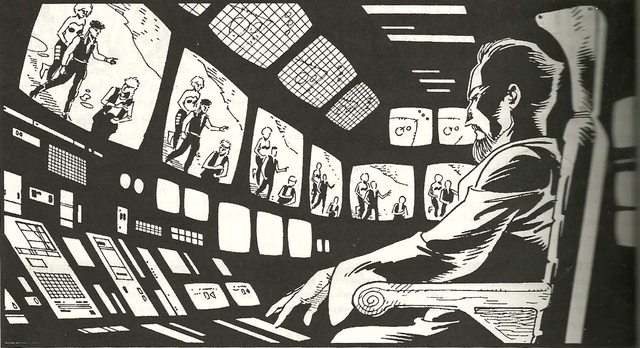
The last chapter basically provides you with two meta-settings that still let you run Games in any genre but with an overarching conflict- the Reality War. In the Reality War, a shadowy evil force is out to dominate all the universes of the Multiverse, and your heroes are working for a Good organization to stop them. You get dumped in a new dimension each time to fight a new evil and stop the baddies.
The Magister Conflict is the fantasy flavor of this. A council of seven wizards from different realities have summoned the Multiverse Knights to be dispatched to various realms where Evil has invaded. They can give vague signs of what rules the Game will have ("Your magic will not work… it takes place in the island realms of this world…" etc.), just like a GM. The players have Amulets of Power which retain their important traits from Game to Game, and they can use them to reshape their powers before entering each new universe. You can even grab items from Lord Hawking's Mystic Bag (which sounds dirtier than it probably is), and your Amulets also have a resurrection spell which can restore you between Games, at the cost of half your personal Power (i.e. Game Points.)
Technowarriors is the sci-fi version. Seven psychic Technolords have the power to monitor time and space, and get information on what disturbances the forces of Evil are causing and what powers will be usefl. Players travel via the Matter Shaper, and use a special Datalink to change their powers. They get their items from the Matter Shaper as well, and it retains a "copy" of their bodies which can be used to resurrect them between Games (again you lose half your GPs.)
The book ends with a suggestion that you can come up with other concepts, and even solicits feedback for a potential Magister/Technowarriors sourcebook that never came about. It reminds the players that in Dream Park, you're limited only by your imagination, "And you've got plenty of that." Well, if you say so.
And that's the Dream Park core book! Overall a fun game- it clearly predates the era of meticulous design but if you're willing to work with a few rough patches, it's got a nice fast-action feel. I own two modules that I will get into in a little bit, and a GM Kit that may merit a post. Hope you've enjoyed it so far!